History of Paper
Paper is a thin material produced from natural (or very rarely artificial) fibers, pressed together into solid structure after they were loosened in a hot water. This recipe was established more than 2000 years ago in Ancient China, and from that time it changed very little, only being enhanced by occasional advances of chemistry which caused creation of countless variations of paper types. Today, we are using paper all around us, and not only to write or paint on it, but also as a widely versatile material that can be used almost anywhere. Asian cultures use it as food ingredient, we interact with it any time when we buy something in stores, building materials for houses and various installations, cleaning products and much more.

Paper History
We could not imagine world today without paper, but if we look only few centuries to the past, its presence was significantly less noticeable. Here you can read more about origins of paper and its journey through history.
Paper Invention
Paper was invented in ancient china some 2200 years ago, but was popularized by one inventor – Cai Lun. Here you can learn much more about his life, work, and his legacy that is still impacting our daily lives.
Paper Facts
Paper is an extremely versatile material that has managed to infiltrate all facets of our modern culture – from being a writing surface to industrial construction material. Read more about interesting paper facts.
Making Paper
If you have ever wondered how paper is made today, here is the perfect place to get all the information about papermaking production process, raw materials and chemicals that are used by the paper industry.
Brief History
Being used in Ancient China since 2nd century BC, paper made a little impact until inventor Cai Lin managed to refine its production process, enabling the beginning of the true revolution of paper products all across the china. His technique could be used to reliable and quickly create small sheets of paper from heated wood chips, rags, cotton and fishnets (all natural materials rich in fibers), but they prevented creation of large paper sheets. The largest possible paper sizes were created rarely, and were used as writing or painting scrolls for Chinese royalty and nobility, and later on Japanese nobility where paper was truly accepted in every facet of their culture (most famously, as a building material of their houses that had parts of walls made from strong paper).
By 8th century, recipe of paper production arrived into the hands of Arabs, who quickly created their networks of paper mills all across their territories – from western border of China to the Northwestern Africa. During the time when Europeans did not have contact with the Arab paper (8th – 11th century), Islamic inventors, artists and book artisans managed to create widely accepted fashion culture around paper, making this still very expensive product used only in exclusive objects, such as paintings, extravagant decorations and off course books that were rarely made because of complexity of art and man-hours that had to be invested to create them. However, by early 11th century Crusades disrupted main centers of paper production in the Holy Land, shifting that production to other areas and pushing it closer toward Europe.
Spain and Sicily were the first countries that started using paper produced by Muslim paper mills in 11th century, and slowly as decades went paper mills started springing up all across Europe. First they appeared in France and Italy, moved northern to Germany, Holland and England, and after that they could be found everywhere. However, this did not mean that paper was suddenly cheaper and more available to everyone. On the contrary, paper was then still expensive, and less durable than parchment – paper-like structure created form the skin of animals. Even when Gutenberg created his moveable type machine for printing books, he continued using parchment because he and his compatriots feared that paper is will not be able to withstand the effects of long term exposure to air and moisture (they knew for certain that parchment and vellum papers could be stored for thousand years in right conditions).
Paper become widely available only after Fourdrinier paper machine became widespread across Europe and North America during 19th century. Ability to create continuous roll of paper powered by the steam machinery revolutionized paper industry completely, enabling it to become integral part of our modern history.
Today, United States and China produce the majority of paper used today, and many governments try desperately to regulate its production, recycling, reduce effects of pollution, deforestation and other environmental hazards that accompany industrial paper production.
The Invention of Paper
Who Invented Paper, and When?
Robert Essel NYC / Getty Images
- Figures & Events
- Southeast Asia
- Middle East
- Central Asia
- Asian Wars and Battles
- American History
- African American History
- African History
- Ancient History and Culture
- European History
- Latin American History
- Medieval & Renaissance History
- Military History
- The 20th Century
- Women's History
- Ph.D., History, Boston University
- J.D., University of Washington School of Law
- B.A., History, Western Washington University
Try to imagine life without paper. Even in the era of emails and digital books, paper is all around us. Paper is in shopping bags, money, store receipts, cereal boxes, and toilet paper. We use paper in so many ways every day. So, where did this marvelously versatile material come from?
According to ancient Chinese historical sources, a court eunuch named Ts'ai Lun (or Cai Lun) presented the newly-invented paper to the Emperor Hedi of the Eastern Han Dynasty in 105 CE. The historian Fan Hua (398-445 CE) recorded this version of events, but archaeological finds from western China and Tibet suggest that paper was invented centuries earlier.
Samples of even more ancient paper, some of it dating to c. 200 BCE, have been unearthed in the ancient Silk Road cities of Dunhuang and Khotan, and in Tibet. The dry climate in these places allowed the paper to survive for up to 2,000 years without entirely decomposing. Amazingly, some of this paper even has ink marks on it, proving that ink was invented much earlier than historians had supposed.
Writing Materials Before Paper
Of course, people in various places around the world were writing long before the invention of paper. Materials such as bark, silk, wood, and leather functioned in a similar way to paper, although they were either much more expensive or heavier. In China, many early works were recorded on long bamboo strips , which were then bound with leather straps or string into books.
People world-wide also carved very important notations into stone or bone, or pressed stamps into wet clay and then dried or fired the tablets to preserve their words. However, writing (and later printing) required a material that was both cheap and lightweight to become truly ubiquitous. Paper fit the bill perfectly.
Chinese Paper-Making
Early paper-makers in China used hemp fibers, which were soaked in water and pounded with a large wooden mallet. The resulting slurry was then poured over a horizontal mold; loosely-woven cloth stretched over a framework of bamboo allowed the water to drip out the bottom or evaporate, leaving behind a flat sheet of dry hemp-fiber paper.
Over time, paper-makers began to use other materials in their product, including bamboo, mulberry and different types of tree bark. They dyed paper for official records with a yellow substance, the imperial color, which had the added benefit of repelling insects that might have destroyed the paper otherwise.
One of the most common formats for early paper was the scroll. A few long pieces of paper were pasted together to form a strip, which was then wrapped around a wooden roller. The other end of the paper was attached to a thin wooden dowel, with a piece of silk cord in the middle to tie the scroll shut.
The Spread of Paper-Making
From its point of origin in China, the idea and technology of paper-making spread throughout Asia. In the 500s CE, artisans on the Korean Peninsula began to make paper using many of the same materials as Chinese paper-makers. The Koreans also used rice straw and seaweed, expanding the types of fiber available for paper production. This early adoption of paper fueled the Korean innovations in printing, as well. Metal movable type was invented by 1234 CE on the peninsula.
Around 610 CE, according to legend, the Korean Buddhist monk Don-Cho introduced paper-making to the court of Emperor Kotoku in Japan . Paper-making technology also spread west through Tibet and then south into India .
Paper Reaches the Middle East and Europe
In 751 CE, the armies of Tang China and the ever-expanding Arab Abbasid Empire clashed in the Battle of Talas River , in what is now Kyrgyzstan. One of the most interesting repercussions of this Arab victory was that the Abbasids captured Chinese artisans, including master paper-makers like Tou Houan, and took them back to the Middle East.
At that time, the Abbasid Empire stretched from Spain and Portugal in the west through North Africa to Central Asia in the east, so knowledge of this marvelous new material spread far and wide. Before long, cities from Samarkand (now in Uzbekistan ) to Damascus and Cairo had become centers of paper production.
In 1120, the Moors established Europe's first paper mill at Valencia, Spain (then called Xativa). From there, this Chinese invention passed to Italy, Germany, and other parts of Europe. Paper helped spread knowledge, much of which was gleaned from the great Asian culture centers along the Silk Road, that enabled Europe's High Middle Ages.
Manifold Uses
Meanwhile, in East Asia, paper was used for an enormous number of purposes. Combined with varnish, it became beautiful lacquer-ware storage vessels and furniture. In Japan, the walls of homes were often made of rice-paper. Besides paintings and books, paper was made into fans, umbrellas, even highly effective armor. Paper truly is one of the most wonderful Asian inventions of all time.
History of China, "Invention of Paper in China," 2007.
" The Invention of Paper ," Robert C. Williams Paper Museum, Georgia Tech, accessed Dec. 16, 2011.
"Understanding Manuscripts," International Dunhuang Project, accessed Dec. 16, 2011.
Wei Zhang. The Four Treasures: Inside the Scholar's Studio , San Francisco: Long River Press, 2004.
- The Invention of Paper Money
- The Invention of the Wheelbarrow
- Culture, War, and Major Events in Asian History
- The Invention of the Crossbow
- The Invention of the Mirror
- The Invention of the Saddle Stirrup
- The Invention of the Seismoscope
- The Invention of Gunpowder: A History
- The Great Rivalry Between Nomads and Settled People in Asia
- How the Black Death Started in Asia
- What Does the Word 'Aryan' Actually Mean?
- What Is a Sphere of Influence?
- Comparative Colonization in Asia
- What You Should Know About Unequal Treaties
- Asia's Worst Dictators
- Which Asian Nations Were Never Colonized by Europe?
- Research and Innovation
- Impact and Outreach
- Student Success
- Honors and Awards
- Alumni and Friends
A Brief History of Paper: From Recording History to Wrapping Gifts
Oh, it’s the most wonderful time of the year, and however you celebrate winter holidays, you are almost guaranteed to use paper. Paper products and natural wood chemicals like cellulose are used everywhere, from holiday cards to the luggage you use when visiting family.
But how did our society transition from using paper for utilitarian purposes like writing literature and recording history to uses like wrapping gifts? To understand this, we have to first understand what papermaking is. In essence, it’s the formation of a matted sheet that’s usually derived from the cellulose fibers of plant and vegetable cell walls.
A Brief History of Paper
Before paper, we used materials like stone and bone to record history and communicate with one another. It didn’t look anything like the lined and perforated paper we commonly use now.
Egyptians created a material similar to paper in 3000 B.C. using papyrus , a plant reed that only grew regionally. Because it was very expensive to purchase papyrus outside of Egypt, parchment was invented in Pergamon in West Asia around 150 B.C. Made from animal skins, parchment was even more expensive than papyrus.
Around 100 B.C. in China, a government official named Ts’ai Lun was the first to make what we now commonly think of as paper from finely chopped mulberry bark and hemp rags. He mixed the materials with water, mashed it flat, pressed out excess water and let it dry in the sun.
Comparing this method to modern papermaking, the concepts are still the same, according to Lucian Lucia, Associate Professor in the Department of Forest Biomaterials . However, as modern technology advanced, we no longer make paper by hand but rather mechanically or chemically.
Throughout this large expanse of time, people across the world were using paper products to wrap gifts. Koreans have been wrapping gifts in bojagi for thousands of years, while Japan’s furoshiki method has been in use since the 1600s. In the United States, however, the invention of wrapping paper as we know it today was a complete accident.
A Mistake That Created an Industry
Before the 20th century, wrapping gifts was largely an upper-class tradition of using elaborately decorated paper, lace and ribbons. At the turn of the century, the most widespread gifting practice was tissue paper, mainly colored red, green or white. But in 1917, the paper industry was forever changed — again.
Business was booming for two brothers running a stationery store in Kansas City, Missouri. J.C. and Rollie Hall were helping customers when they realized they had run out of the standard tissue paper needed for the busy holiday season. It wasn’t like today when you can simply get one-day delivery on Amazon goods. They needed a solution, and fast.
Rollie found leftover “fancy French paper” not meant for wrapping gifts, but for lining envelopes. As a last-second effort to keep business steady, they put that paper out on display for 10 cents a sheet. It sold out in minutes.
The Hall brothers tested their luck in 1918, and the paper sold out again just as fast. The following year, they decided to focus their efforts on creating their own version of the “fancy French paper,” and thus the wrapping paper industry was born.
Over time, using wrapping paper became almost an expectation in western cultures, creating a $16.2 billion industry in 2019 . Now you can buy custom wrapping paper. Ironically, you can even buy a print that looks like wood .
Oh, and the Hall brothers? They named their store Hallmark.
The Future of Paper
Since 1929 , the College of Natural Resources has educated leaders in the forestry and forest biomaterials industries, creating innovative solutions to real-world problems. Today, the Department of Forest Biomaterials is at the forefront of sustainable bioenergy and bioproducts.
Paper and its derivatives are being used across all industries from biomedical to energy. For example, Joe Sagues, a Ph.D. student in the department, is researching ways to turn biomass like sawdust into lithium-ion batteries, which is potentially a much greener way of making energy.
The department is also leading the world in exploring how consumer patterns and demand can be met with sustainable products, specifically with hygiene tissue. Consumers often take for granted how much paper and energy is used to make those essential items. However, NC State recognized this opportunity and hosted the only international, university-sponsored conference on sustainable hygiene tissue in June 2019. It will host the conference again in January 2021.
As the department is finding, paper can be used for almost anything and is, in fact, currently used in more products than we think. Do you enjoy ice cream? That rich, smooth texture comes from cellulose. Paper can also be used in chemistry to safely conduct experiments at a microscale. We can even print circuit boards on paper for communication and radio tagging. “There’s almost nothing that you can’t do with paper,” Lucia said.
As we look to a future with a growing population, understanding and using sustainable materials has never been more important. Lucia sees paper as the answer to most of our consumer goods problems. “We really should look to it as a sustainable medium for better living,” he said. “We can make anything out of paper. So it’s just a question of: Is society willing to demand that?”
- forest biomaterials
- Paper Packaging and Tissue
- paper science and engineering
More From College of Natural Resources News
Fall foliage in north carolina: what to expect this year, russian invasion of ukraine could have lasting impacts on global economy, environment, nc state student uses ai to boost team usa's olympic breaking performance.
- Fundamentals NEW
- Biographies
- Compare Countries
- World Atlas
Related resources for this article
- Primary Sources & E-Books
Introduction
Long ago the Chinese discovered that a thin, wet layer of tiny, interlocking fibers becomes paper when it dries. For many centuries paper was used mainly for printed works, for writing letters, and for keeping records. Today paper comes in thousands of types and grades and includes paperboard for packing and construction; newsprint; photocopying and printing papers; papers for writing and wrapping; and papers used for countless consumer products. Despite the popularity of computers and the rising costs of papermaking, worldwide demand for paper products remains strong.
Paper, paperboard, and pulp are produced in nearly all countries, though the industrialized nations dominate the market. China and the United States are the leading manufacturers; other major paper-producing countries are Japan and Germany. The annual output of paper mills worldwide totaled more than 400 million metric tons of paper and paperboard in 2011; American consumers used more than 70 million tons of paper and board during the same year.
Raw Materials of Paper
Part of the future increase in pulp and paper production will depend on the cultivation of fast-growing tree species in warmer climates and on tree plantations where forests are harvested for commercial use. New technologies in paper production should help conserve forest resources and develop even more uses for this versatile product. ( See also conservation ; forest and forestry ; lumber .)
The first papermaking materials were those used by the Chinese and consisted of fibers from rags, the bark of trees, and plants and grasses such as hemp, bamboo, jute, and straw. Early Europeans and Americans made high-quality writing paper from cotton and linen rags. Fine writing papers are still made partly or entirely from cloth fibers. Paper that contains bamboo, esparto, straw, and squeezed sugarcane (bagasse) is produced mainly in developing countries. ( See also plant ; wood .)
Most paper and paper products manufactured today use fibers derived from wood, primarily from conifers—such as spruce, fir, pine, and hemlock—and deciduous trees—including birch, oak, and aspen. In addition to wood fibers, most writing and magazine papers contain between 1 and 30 percent mineral filler, such as calcium carbonate and clay. These materials, which make paper smoother, less absorbent, and more opaque, improve its optical and printing qualities. ( See also printing .)
Preparing the Pulp
Pulp can be produced through mechanical or chemical processes. These methods were first discovered in the 19th century.
Mechanical Pulping
Originally, fibers were obtained by forcing logs against a grindstone, which turned 90 percent of a log into pulp. The groundwood pulp was then mixed with rag fibers and made into newsprint. As the process gradually improved, chemical fibers were added to the groundwood. In the 1960s a new method was invented in which wood chips were made into pulp in an attrition mill, known as a disk refiner. Groundwood pulp, however, contains such substances as lignin, which binds the fibers. Chemical processes were developed in the 1800s that dissolved most of these substances. Manufacturers now vary fiber quality in the pulp-making process by controlling temperature and pressure and by using chemical additives. These pulps are called refiner mechanical pulps, thermomechanical pulps, or—when small amounts of chemicals are added—chemical-mechanical pulps.
Chemical Pulping
The use of chemical pulping increases the strength of wood fibers and produces material to make finer-grade papers. Wood chips for the chemical processes are dumped into large digester tanks and cooked with steam in chemical solutions called cooking liquors. Cooking times vary from two to about six hours, depending on the kind of chemicals used and degree of refinement needed. Pulps are named after the processes used to make them.
The kraft process, first discovered in 1874, accounts for 80 percent of the world’s chemical pulp production. Kraft (from the German word for strength) uses sodium hydroxide and sodium sulfide in the cooking liquor. This pulping process is carried out in continuous digesters and yields the strongest fiber for paper. Kraft pulping is particularly effective for some pines that, because they contain resins, waxes, and fats, resist other pulping methods. Manufacturers can also recycle chemicals and recover much of the heat used in this process, making it highly energy efficient. By using chlorine dioxide, kraft pulps can be bleached in several stages to a high brightness. Several kinds of paper are made from kraft pulping, including bag, boxboard, and—in higher grades—book, magazine, writing, wrapping, and specialty papers.
Other methods of chemical pulping account for the remaining 20 percent of world pulp production. The alkaline-soda process, for example, is used mainly to pulp some hardwoods. Bulky papers such as blotters are made of soda pulp. The neutral-sulfite process is used to pulp some hardwoods and softwoods. The cooking liquor is sodium sulfite and is either entirely neutral or slightly alkaline.
In between the mechanical-process and fully cooked chemical pulps are pulps produced by varying the amount of chemical and mechanical treatment. Usually the same chemicals are used as those found in chemical pulping liquors but under more dilute conditions. Sodium hydroxide, sodium sulfite, or sodium sulfide are the most commonly used chemicals. The particular chemical included in the liquor depends on the wood species and the paper product required. Because this process does not completely dissolve undesired substances in the pulp, chemimechanical pulps require more mechanical treatment before they can be used. Chemimechanical pulps are made into lower-grade wrapping, book, and bond papers.
Final Pulping Operations
Additional refining steps include many washings; screening out bits of knots, sand, and other foreign matter; bleaching with chemicals; and beating ( see bleaching ). These steps require huge amounts of clean water, so most pulp and paper mills are built close to a large water supply.
Bleaching removes the residual lignin and brightens the pulp. For environmental reasons some of the chlorine chemicals are being replaced by oxygen and peroxide. Mechanical pulps are also bleached with peroxide and hydrosulfites so they can be used to make higher-grade products.
Finally, the pulp must be conditioned—a step known as beating, or refining. The pulp, either in liquid form or in thick, almost-dry sheets called laps, is mixed and refined. The fibers are frayed, sheared, and cut so they will cling together when matted.
Chemicals also are added to the pulp at this point. Sizing (resins, starch, or gypsum) strengthens the paper and makes it water-repellent. Loading materials (clay, pigments, and chalk) form a surface coating and make the paper opaque. Fillers and dyes for coloring may also be added to the mixture.
In the last step, the pulp passes through a Jordan, a cone-shaped machine that cuts the fibers to the proper length. The final pulp product, called furnish or stuff, is stored until needed in the head boxes of papermaking machines.
Papermaking
In most countries nearly all paper is made by machines. The most widely used machines are the Fourdrinier and the cylinder.
Fourdrinier Machine
The Fourdrinier, which was invented in France in 1799, can make webs (long sheets) of paper from 5 to 30 feet (1.5 to 9 meters) wide at a speed exceeding 3,300 feet (1,000 meters) per minute. At the wet end—where the process starts—the furnish flows from a head box onto a swift-moving fine wire mesh that traps and mats most of the fibers. Much of the water drains away, and the web is carried on belts of felt through press rolls that squeeze more water from it.
At the dry end of the machine, the web passes over and under a series of heated drying rolls. It then runs through a calender stack where it is pressed smooth by cast-iron rolls and then wound on a reel. Enamel-coated papers can be made on the Fourdrinier by adding kaolin, chalk, or other pigments when the web is partly dried.
Cylinder Machine
A cylinder machine can make many kinds of paper but is particularly adapted to making paperboard, light papers, and tissues. In the cylinder machine, the furnish is picked up by revolving, cloth-covering cylinders that are partly immersed in a vat of furnish.
The web is deposited on a screen, then transferred onto felt conveyors that carry it to press and drying rolls. Paperboard is made by laying one or more still-moist webs on top of another and pressing the different layers together. Thin sheets and tissues are made from the web of a single cylinder.
Weights and Sizes of Paper
The weight of a paper is determined by weighing several sheets of paper of uniform size. In the United States printing papers are sold in reams of 500 sheets. Ream sizes and weights are based on the old method of papermaking when paper was made in individual sheets and the sheet mold determined the paper’s dimensions.
The most common standard sizes today for printing and writing papers, given in inches, are as follows: writing—17 × 22; book—25 × 38; cover—20 × 26; cardboard—22 × 28. If a ream of 8 1 / 2 × 11 writing paper is marked 20-pound bond, it means that the paper was cut from the original 17 × 22 sheets, which weighed 20 pounds per ream.
Types of Paper
Paper can be classified on the basis of use and weight into two general categories: printing grades and industrial grades.
Printing Grades
Printing grades are newsprint and catalog, rotogravure, and magazine papers made from mechanical and thermomechanical pulps. They often contain from 1 to 15 percent chemical pulps. Most of the mechanical pulp is unbleached, though bleached pulps are used. Magazine papers frequently are coated on one or both sides with clay or calcium carbonate. These papers are used for such printed items as business reports, advertising brochures, and quality magazines in which the quality of color reproduction is of great concern. ( See also printing .)
Another class of printing papers includes stationery and copying and computer papers. These are made from bleached softwood and hardwood pulps. Fillers, either clay or calcium carbonate, are added to the furnish to improve the printing quality of their surfaces. More expensive grades often contain cotton, linen, or other rag fibers.
Book paper is made from a variety of furnishes. Paperback books are printed on papers containing mechanical pulp, which deteriorates rapidly when exposed to light and heat. Papers for softcover or hardcover books can be long lasting if they are made from fully bleached fibers and sized under alkaline conditions. Hardcover books are made with less acidic pulps, and finer-quality book paper contains rag fibers. ( See also book and bookmaking .)
Industrial Grades
Industrial grades include bag paper, linerboard, corrugated cardboard, and papers used in consumer products. Bag paper and glassine (dense transparent or semitransparent) paper are gradually being replaced by plastic materials. Production of other industrial paper grades is increasing, however, particularly for boxes and construction use and for such consumer products as tissues, diapers, and food packaging.
Paper Handicrafts
In addition to its commercial uses, paper is a versatile material for handicrafts. In about 1500 in Europe decorative papers were used as the first examples of modern wallpaper. The introduction of block printing in the 17th century greatly improved the quality of these papers ( see wall covering ).
Developed first in Asia, papier-mâché (French for “chewed paper”) is another paper craft widely practiced today. When paper is soaked in water and mixed with glue, paste, or other such materials, it can be formed into different shapes that harden when the water is removed. An inexpensive material, papier-mâché is used in making theater props and sets, toys, and masks, and in various art and craft projects.
One of the most beautiful paper handicrafts is origami (Japanese for “paper folding”). Developed in Japan, origami is the art of creating objects by folding a sheet of paper in precise steps. The created forms range from simple figures to complex designs complete with moving parts. Originally used for ceremonial purposes, origami today is a handicraft enjoyed worldwide. It has been especially popular as an art form and a hobby in Spain and Latin America.
Recycling Paper
In most industrialized countries recycled paper provides a significant part of the fiber supply. Besides conserving forest resources, recycling produces fewer pollutants than do conventional pulping and bleaching processes. Recycling begins with the classification of waste paper. Relatively clean wastes such as box and corrugated paper and medium or high-grade office papers require little treatment. The paper is made into pulp mechanically in hot water under alkaline conditions. After a number of screening and washing operations, the fiber is ready for reuse.
Lower grades of wastepaper must be cleaned more thoroughly during fiber disintegration and screening in order to remove contaminants. Pulp from wastepaper may be bleached to improve its quality.
Newsprint, magazine, and other printed materials require special chemical cleaning processes to remove the ink. The dispersed ink particles are removed by extensive washing over screens or through a flotation process. Chemicals and air are added to the dispersed pulp in a specially designed flotation cell. The lighter ink particles rise to the surface of the pulp slurry and are skimmed off.
History of Papermaking
Paper gets its name from the Egyptian papyrus plant, used to make paperlike sheets as early as 2300 bc ( see papyrus plant ). The Chinese, before discovering how to make paper, wrote on tablets of silk or bamboo. Europeans recorded documents on the skins of calves, lambs, sheep, and goats.
The Arabs learned the secret of papermaking from the Chinese and introduced paper to Europe in the 12th century ad . Europeans soon developed their own papermaking methods. The first European paper mill was built in 1270 in Fabriano, Italy, a town whose artisans later introduced many improvements to the craft. William Rittenhouse established the first North American paper mill in Germantown, Pennsylvania, in 1690.
The introduction of the practical application of book printing by Johannes Gutenberg in Germany by 1450 greatly increased the need for a steady supply of printing paper. The heightened demand led to the invention of the first papermaking machine, an early version of the Fourdrinier, by French inventor Nicholas-Louis Robert in 1798. A successful version of the Fourdrinier machine appeared in 1812.
In 1809 the Englishman John Dickinson invented the cylinder machine. The first cylinder machine in the United States was put into operation in Philadelphia, Pennsylvania, in 1817. By the beginning of the American Civil War, there were over 500 papermaking companies in the United States producing 60,000 tons of paper each year.
The increasing demand for paper put a heavy drain on rag supplies and sparked a search for other raw materials. In 1840 Friedrich Keller, a German, was the first to find a commercially practicable way to produce paper from wood through mechanical grinding. Wood pulp, combined with some rag fibers, produced newsprint. Although two chemical processes—soda and sulfite—were developed in the mid-1800s, chemical pulping was not used widely for some time.
Today efforts continue to find new raw materials and to improve papermaking methods. Logs and parts of logs unsuitable for sawing into lumber, formerly discarded as waste, are being converted into paper. The latest innovation in papermaking machines has been the introduction of two-wire machines. The pulp slurry is forced between two meshes of wire, and water is removed from both sides of the paper. This innovation not only speeds up the papermaking process, it also improves the quality of paper produced.
It’s here: the NEW Britannica Kids website!
We’ve been busy, working hard to bring you new features and an updated design. We hope you and your family enjoy the NEW Britannica Kids. Take a minute to check out all the enhancements!
- The same safe and trusted content for explorers of all ages.
- Accessible across all of today's devices: phones, tablets, and desktops.
- Improved homework resources designed to support a variety of curriculum subjects and standards.
- A new, third level of content, designed specially to meet the advanced needs of the sophisticated scholar.
- And so much more!
Want to see it in action?
Start a free trial
To share with more than one person, separate addresses with a comma
Choose a language from the menu above to view a computer-translated version of this page. Please note: Text within images is not translated, some features may not work properly after translation, and the translation may not accurately convey the intended meaning. Britannica does not review the converted text.
After translating an article, all tools except font up/font down will be disabled. To re-enable the tools or to convert back to English, click "view original" on the Google Translate toolbar.
- Privacy Notice
- Terms of Use

- History & Society
- Science & Tech
- Biographies
- Animals & Nature
- Geography & Travel
- Arts & Culture
- Games & Quizzes
- On This Day
- One Good Fact
- New Articles
- Lifestyles & Social Issues
- Philosophy & Religion
- Politics, Law & Government
- World History
- Health & Medicine
- Browse Biographies
- Birds, Reptiles & Other Vertebrates
- Bugs, Mollusks & Other Invertebrates
- Environment
- Fossils & Geologic Time
- Entertainment & Pop Culture
- Sports & Recreation
- Visual Arts
- Demystified
- Image Galleries
- Infographics
- Top Questions
- Britannica Kids
- Saving Earth
- Space Next 50
- Student Center
- Introduction
Improvements in materials and processes
Introduction of machinery.
- Wastepaper and paperboard
- Natural fibres other than wood
- Synthetic fibres
- Mechanical or groundwood pulp
- Chemical wood pulp
- Semichemical pulp
- Bleaching and washing
- Preparation of stock
- Formation of paper sheet by machines
- Finishing and converting
- The world paper industry
- Substance and quantity measurement
- Strength and durability
- Optical properties
- Groundwood and newsprint papers
- Kraft wrapping
- Paperboards
- Sanitary papers
papermaking
Our editors will review what you’ve submitted and determine whether to revise the article.
- How Stuff Works - Home and Garden - How to Make Paper for Kids
- Table Of Contents
papermaking , formation of a matted or felted sheet, usually of cellulose fibres, from water suspension on a wire screen. Paper is the basic material used for written communication and the dissemination of information. In addition, paper and paperboard provide materials for hundreds of other uses, such as wrapping, packaging, toweling, insulating, and photography.

The word paper is derived from the name of the reedy plant papyrus , which grows abundantly along the Nile River in Egypt . In ancient times, the fibrous layers within the stem of this plant were removed, placed side by side, and crossed at right angles with another set of layers similarly arranged. The sheet so formed was dampened and pressed. Upon drying, the gluelike sap of the plant, acting as an adhesive, cemented the layers together. Complete defibring, an indispensable element in modern papermaking, did not occur in the preparation of papyrus sheets. Papyrus was the most widely used writing material in ancient times, and many papyrus records still survive.
The papermaking process
Historical development.
Papermaking can be traced to about ad 105, when Ts’ai Lun , an official attached to the Imperial court of China , created a sheet of paper using mulberry and other bast fibres along with fishnets, old rags, and hemp waste. In its slow travel westward, the art of papermaking reached Samarkand , in Central Asia , in 751; and in 793 the first paper was made in Baghdad during the time of Hārūn ar-Rashīd, with the golden age of Islāmic culture that brought papermaking to the frontiers of Europe .
By the 14th century a number of paper mills existed in Europe, particularly in Spain, Italy, France, and Germany. The invention of printing in the 1450s brought a vastly increased demand for paper. Through the 18th century the papermaking process remained essentially unchanged, with linen and cotton rags furnishing the basic raw materials. Paper mills were increasingly plagued by shortages; in the 18th century they even advertised and solicited publicly for rags. It was evident that a process for utilizing a more abundant material was needed.
In 1800 a book was published that launched development of practical methods for manufacturing paper from wood pulp and other vegetable pulps. Several major pulping processes were gradually developed that relieved the paper industry of dependency upon cotton and linen rags and made modern large-scale production possible. These developments followed two distinct pathways. In one, fibres and fibre fragments were separated from the wood structure by mechanical means; and in the other, the wood was exposed to chemical solutions that dissolved and removed lignin and other wood components, leaving cellulose fibre behind. Made by mechanical methods, groundwood pulp contains all the components of wood and thus is not suitable for papers in which high whiteness and permanence are required. Chemical wood pulps such as soda and sulfite pulp (described below) are used when high brightness, strength, and permanence are required. Groundwood pulp was first made in Germany in 1840, but the process did not come into extensive use until about 1870. Soda pulp was first manufactured from wood in 1852 in England, and in 1867 a patent was issued in the United States for the sulfite pulping process.
A sheet of paper composed only of cellulosic fibres (“waterleaf”) is water absorbent. Hence, water-based inks and other aqueous liquids will penetrate and spread in it. Impregnation of the paper with various substances that retard such wetting and penetration is called sizing .

Before 1800, paper sheets were sized by impregnation with animal glue or vegetable gums, an expensive and tedious process. In 1800 Moritz Friedrich Illig in Germany discovered that paper could be sized in vats with rosin and alum. Although Illig published his discovery in 1807, the method did not come into wide use for about 25 years.
Discovery of the element chlorine in 1774 led to its use for bleaching paper stock. Lack of chemical knowledge at the time, however, resulted in production of inferior paper by the method, discrediting it for some years. Chlorine bleaching is a common papermaking technique today.
Prior to the invention of the paper machine, paper was made one sheet at a time by dipping a frame or mold with a screened bottom into a vat of stock. Lifting the mold allowed the water to drain, leaving the sheet on the screen. The sheet was then pressed and dried. The size of a single sheet was limited to the size of frame and mold that a man could lift from a vat of stock.
In 1798 Nicolas-Louis Robert in France constructed a moving screen belt that would receive a continuous flow of stock and deliver an unbroken sheet of wet paper to a pair of squeeze rolls. The French government recognized Robert’s work by the granting of a patent.
The paper machine did not become a practical reality, however, until two engineers in England, both familiar with Robert’s ideas, built an improved version for their employers, Henry and Sealy Fourdrinier , in 1807. The Fourdrinier brothers obtained a patent also. Two years later a cylinder paper machine (described below) was devised by John Dickinson , an English papermaker. From these crude beginnings, modern papermaking machines evolved. By 1875 paper coated by machinery was being made for use in the printing of halftones by the new photoengraving process, and in 1884 Carl F. Dahl invented sulfate (kraft) pulp in Danzig, Germany.
Although the paper machine symbolizes the mechanization of the paper industry, every step of production, from the felling of trees to the shipment of the finished product, has also seen a dramatic increase in mechanization, thus reducing hand labour. As papermaking operations require the repeated movement of large amounts of material, the design and mechanization of materials-handling equipment has been and continues to be an important aspect of industry development.
Although modern inventions and engineering have transformed an ancient craft into a highly technical industry, the basic operations in papermaking remain the same to this day. The steps in the process are as follows: (1) a suspension of cellulosic fibre is prepared by beating it in water so that the fibres are thoroughly separated and saturated with water; (2) the paper stock is filtered on a woven screen to form a matted sheet of fibre; (3) the wet sheet is pressed and compacted to squeeze out a large proportion of water; (4) the remaining water is removed by evaporation; and (5) depending upon use requirements, the dry paper sheet is further compressed, coated, or impregnated.
The differences among various grades and types of paper are determined by: (1) the type of fibre or pulp, (2) the degree of beating or refining of the stock, (3) the addition of various materials to the stock, (4) formation conditions of the sheet, including basis weight, or substance per unit area, and (5) the physical or chemical treatment applied to the paper after its formation.
- Oil Painting
- Watercolour Painting
- Acrylic Painting
- Pastel Painting
- Printmaking
- Studio and General
- Glossary of Art Terms
- Submit Your Idea
- Artist Interviews
- Features & Editorials
- Shop Materials
- Jackson’s Art Prize
- Online Gallery

The History of Paper
Paper is one of humanity’s most important inventions, helping to document and preserve information for thousands of years. Ahead of the release of our Paper Guide , read our article on the history of paper from 3100 B.C. to the present.
Featured Image: Illustration demonstrating an early method of papermaking – bamboo was treated and boiled to make a pulp, and then a fine screen was dipped in the mixture. A thin layer of fibres would cling to the screen, which would then be pressed and dried.
In China, papermaking is taught as one of their ‘Four Great Inventions’, along with printing, gunpowder, and the compass. While paper has been instrumental in keeping records of history, the history of paper itself is unclear. Nobody knows the exact origins of paper, however, we do have artefacts that point to its early inception.

The oldest known fragment of paper. A part of a map was discovered in 1986 at the archaeological site Fangmatan, near Tianshui in the Gansu province of China. The remnant shows topographic features including mountains, waterways, and roads, and is believed to have been placed on the chest of a man buried in the tomb in which it was found. It is thought to date back to the beginning of the second century B.C.
Circa 3100 B.C.
The first known use of Papyrus, from which we get the modern word ‘paper’, is documented in Egypt during the First Dynasty. Papyrus is made from the pith of the Papyrus plant, known to grow on the marshy areas near the river Nile. It was also used to make items such as reed boats, mats, rope, sandals, and baskets.
Whereas papyrus is a lamination (layering) of natural plant fibres, paper is manufactured from fibres whose properties have been changed by maceration (soaking in water). Papyrus is known to have been used as a writing surface until around 1100 A.D.

200 – 101 B.C.
Before the use of paper became widespread in the country, writers used bamboo or pieces of silk. Silk was lightweight and convenient, but expensive. Bamboo was cheap and readily available, but heavy to store and transport. Paper was both cheaper than silk and more practical than bamboo. The Chinese were the first to have a rudimentary papermaking process. This practice is thought to have begun around this time. The first papers were used to pack delicate bronze mirrors.

A late Eastern Han (25–220 A.D.) Chinese tomb mural showing scenes of a banquet, dance and music, acrobatics, and wrestling, from the Dahuting Tomb in Zhengzhou, Henan province.
A eunuch in the Han Court named Cai Lun improved and standardised paper production by using inexpensive materials.
201 – 300 A.D.
Papermaking is introduced to Vietnam.
Paper began to be used as a writing surface in China.
300 – 650 A.D.
Paper was introduced to Korea in around 350. A papermaking process was developed that produced glossy white paper, which was often sent to China as a tribute and gift for the knowledge they contributed to Korea’s papermaking expertise. Korean paper at this time garnered a reputation for being particularly well suited to painting and calligraphy.
In 610, the Korean Buddhist priest Doncho brought the Chinese method of making ink and paper to Japan. The Prince Regent Shotoku of Japan found the paper was too fragile, and so introduced kozo and hemp fibres to the paper pulp, which made the paper stronger. Today, Japanese papers known as washi are used internationally, in particular for relief printmaking. Many of these papers still use the same kozo and hemp fibres that date back to this time.
In around 620, block printing on paper began in China, which drastically increased the demand for paper. Paper was also manufactured into hats, clothes, stiffened for armour, and thinned for windows, screens, books, maps, and money. At this time, the beginning of the Tang Dynasty, fine paper was made from straw of rice and bark of wingceltis at Xuancheng. This is the earliest known production of what we call rice paper, although, at the time, silk paper was more popular for writing on.

Song Dynasty Jiaozi – the world’s earliest paper money.
In 751 A.D. at the Battle of Talas, it is claimed that two Chinese papermakers were imprisoned in Samarkand. There they shared their knowledge of how to make paper, thus introducing papermaking to Central Asia. However, historians dispute this as possible fiction, and there is archaeological evidence of paper existing in Samarkand before the battle.
Paper from Samarkand was much more durable than papyrus. © 2018 AFP
The relative economy of paper compared to vellum meant that libraries of the Islamic world were vast. Islamic calligraphers wrote with bamboo quills on plant fibre paper, smoothed over with chalk and wheat starch.
Circa 750 A.D.
From Central Asia, the Islamic civilisation spread papermaking practices, using hemp, flax, cotton, old rags, and rope, to the Middle- East. This knowledge reached Europe a few centuries later, before spreading to other parts of the world. The word ‘ ream ’ also came from this time, derived from the Arabic word ‘rizma’, meaning ‘bundle’.

Early wooden printing press. Such presses could produce up to 240 impressions per hour.
Papermaking by hand arrived in Europe. Prior to this, artists and writers would use parchment (or vellum), a surface made of processed animal skin that looks and feels like paper.
Because paper was introduced to the West through the city of Baghdad, it was first called ‘bagdatikos’.
New European papers were made from fibrous materials – old fishing nets, fabric bags, clothes, and rags. Italy invested the most within the industry and implemented improvements to develop its technique.
In the second half of the 13th century, the Fabriano paper mill was founded in a small town in the Marche region, producing linen and hemp papers. The mill mechanised rag grinding by using hydraulic hammer mills, significantly reducing the time it took to produce pulp.
When coated with gelatine size these papers resembled the vellum often used for writing manuscripts. Left unsized, it was ideal for printing copperplate engravings.
In 1282 the first watermarks were used in Italian paper manufacture.
Spain became the first European country to produce paper money.
Arches began producing paper. They provided most of the paper used in France up to the late 1700s.
In addition to fine art paper, Arches also produced paper that was used in documents and currency throughout France and during the French Revolution.
Linen and cotton rags imported by papermills were blamed for the spread of the plague in England.
The first American paper mill was established near Philadelphia by William Rittenhouse. The manufacture of paper is now one of America’s biggest industries – there are hundreds of mills in operation, producing millions of tonnes of paper each year.

Claus Rittenhouse House.
Newspapers started appearing in the late 1600s and early 1700s. Increased demand for paper in general stretched the supply of rags until the shortage became so severe that there were rag wars during the mid-1700s, and nations passed laws forbidding rags to be taken out of the country.
1700-1800s.
In the late eighteenth to nineteenth century, industrialisation greatly reduced the cost of manufacturing paper. The bleaching characteristics of chlorine were discovered, and at the end of the eighteenth century this knowledge was used to bleach cotton, the raw material for paper.
A process for removing printing inks from recycled paper, known as de-inking, was invented by German jurist Justus Claproth.
James Whatman invented wove paper at Turkey Mill, in Maidstone, Kent. His initial explorations into wove paper were carried out with printer William Baskerville in 1754. Prior to this development, all machine made paper was ‘ laid ’. Wove paper was a much smoother than laid papers, on which pigments tended to pool in the ridges of the texture.
Wove paper sheets were formed against a woven mesh material, which did away with the prominent uniform lines found in laid papers. Consequently, the quality of printed work, and the scope for what could be printed, increased significantly.
As well as wove paper benefitting the print industry, it was also an exciting development for watercolour artists, including J. M. W. Turner. This was because it was surface sized with gelatine, made with hoofs and bones, making it incredibly strong and absorbent, and sufficiently robust to take wiping, scratching, and scraping. Such subtractive techniques were not previously possible for watercolourists, and Turner became a master of working in such a way.
Other notable artists who favoured working with Whatman paper include John Sell Cotman, William Blake, and Thomas Gainsborough.
Nicolas-Louis Robert of France conceptualised the first machine to produce paper in continuous sheets. The French Revolution put his idea on hold, and he eventually gave his plans to his brother-in-law in England, where the machine was finally completed and patented by Henry and Sealy Fourdrinier, in 1806.
The Fourdrinier is still used to make paper to this day. As an aside, Nicolas-Louis Robert also launched the first hydrogen balloon, and in 1783 ascended in a gondola with his brother, carried by his discovery.

The Phantom on the Terrace, Hamlet (1843) by Eugène Delacroix, Lithograph on Arches wove paper.
Steam-driven papermaking machines were developed, decreasing the cost of production of paper. At this time papermills were exploring the possibility of using wood to make paper. In 1801, Matthias Koops wrote and published the book Historical Account of the Substances Which Have Been Used to Describe Events, and to Convey Ideas, from the Earliest Date, to the Invention of Paper . The book was printed on paper made from wood shavings, not pulped, but glued together. However, despite receiving funding from the Royal family, his book proved prohibitively expensive to make and he soon went bankrupt.
Canadian inventor Charles Fenerty and German F. G. Keller independently developed processes for pulping wood fibres. The introduction of wood pulp meant that paper production was no longer wholly dependent on recycled materials from ragpickers. By the end of the 19th century, most papers were made from wood pulp , with the exception of cotton artist papers.
The first newspaper printed on groundwood paper was created. It was made from coniferous trees, using mechanically ground pulp. Such paper is low cost and non-archival, and is still used in newspaper production today.
Acid-free wood-based paper was developed. Prior to this, wood papers deteriorated quickly because of the alum in the pulp, slowly turning paper to ash. Many books and newspapers perished from this time, creating holes in our history. Important documents had to be printed on expensive rag paper. With the advent of acid-free wood paper came a lower-cost means of producing books and documents, as well as artist papers. Paper that has not been de-acidified is still used to make most paperback books and newspapers.
1953 – 1956.
Four competing paper mills: Arches, Johannot, Marais, and Rives, merged. They formed the French papermaking group, Arjomari (the name is formed from the first two letters of each of the merging companies).
Arjomari merged with fellow French paper producer Prioux-Dufournier, changing its name to Arjomari-Prioux.
By the end of the 1980s, Arjomari-Prioux was one of Europe’s top five paper producers. In 1991, Arjomari-Prioux merged with UK company Wiggins Teape Appleton (a company that had comprised previously of bought companies, including the Buckland Mill in Dover and Appleton papers in the US) to form Arjowiggins Appleton. Today Arjowiggins Appleton is one of the world’s leading producers of paper products.
The Blue Rigi: Lake of Lucerne, Sunrise by J. M. W. Turner was sold at auction for £5.8m, and remains to this day to be the most expensive work on paper. It is painted on Whatman paper made at Turkey Mill, with watercolour, bodycolour, pen, and brown ink, heightened with white chalk and with scratching out.
The Blue Rigi, Sunrise , 1842 Joseph Mallord William Turner Copyright: Photo (c) Tate
Although Whatman watercolour paper is no longer available, St Cuthbert’s Mill in Somerset today produces Millford paper , which is specifically designed to replicate the unique characteristics of Whatman paper.
We’re proud to present our Paper Guide , a studio companion for artists working in a variety of mediums.
Our Paper Guide, released on 8th January 2021
Over 122 pages, our Paper Guide includes the history of paper, the materials and methods used for making it and how these affect its properties, a glossary of paper terms, and in-depth advice to help you choose the very best paper for your painting, drawing, or printmaking.
Printed in the UK on G.F Smith Max, an FSC® certified paper from responsible sources.

Daniel Brady
Daniel writes and commissions features, as well as interviewing artists. With a background in photography and painting, he’s interested in how artists make and exhibit their work. Daniel studied at the University of London, specialising in Literature, History and Art.
You Might Like

How We Collaborate With Artists
At Jackson’s, we love to collaborate with artists. In this article, we ...
On August 8th 2024 by Emily Harman

Jackson’s Facebook Groups
We created Jackson’s Facebook Groups to create an art community group for ...
On June 25th 2024 by Emily Harman

Recreating the Colour Palette of Eric Ravilious
Eric Ravilious (22 July 1903 – 2 September 1942) was a watercolour ...
On June 24th 2024 by Lisa Takahashi

In Conversation With Carole Hübscher and Eric Vitus, Caran d’Ache
We invited the CEO, Carole Hübscher, and the R&D Fine Arts Director ...
On May 28th 2024 by Clare McNamara
Fascinating article!
A good read, learned a lot.
What an eye opener, many thanks to those who researched and published this article!
Latest Posts

Artist Insights: Will Rochfort

Barbara Zankovich: Process of Control

Inside the Sketchbook of Ken Nwadiogbu

Louise Wallace: Ascending Light

Introducing Jackson’s Artist Pigment Sets
Popular tags, jacksons_art.

Newsletter Sign Up
© JACKSON'S ART SUPPLIES 2009-2024 | COOKIES POLICY | JACKSON'S ART SUPPLIES, 1 FARLEIGH PLACE, LONDON N16 7SX 020 7254 0077
- Art Technique
- New & Offers
- Shop Online
© 2009-2019 Jackson's Art Supplies
The Invention of Paper
Jul 31, 2014
650 likes | 2.18k Views
The Invention of Paper. Paper was a great invention from Ancient china. We use paper today in our daily life many ways. I nvention.
Share Presentation
- paper kites
- ancient china
- mulberry bark

Presentation Transcript
The Invention of Paper Paper was a great invention from Ancient china. We use paper today in our daily life many ways.
Invention Paper was invented in China by CaiLun in 105 AD. It was one of the one of the four greatest inventions of the Chinese. He was looking for a device to record events and important things.
How it is made Paper can be made from a variety of materials ranging from tree bark, hemp, rags, etc. CaiLun made paper by mixing finely chopped mulberry bark and hemp rags with water, mashing it till it was flat, and then pressing out the water and letting it dry in the sun.
How Paper was used in Ancient China Paper was mainly used for writing on. They would write on it with a black rock. After a couple years of using paper, people then used it to draw, make clothes, make paper kites, umbrellas, books, and paper fans.
How Paper is used Today in Modern Day America Paper is a big part of America. We use paper to draw pictures, write stories, do homework on, and many other ways.
- More by User
The Invention of Athens
The Invention of Athens. Culture, Politics, and the Persian Wars.
434 views • 27 slides
The Invention of Zero
The Invention of Zero. Joanne, Kristan & Dayle Primary/Junior Math Tuesday January 19th, 2010. Why were numbers needed? To count sheep To keep track of property To keep track of time. These tasks had no use for a zero!!. Egyptians -Had no need for a zero
366 views • 13 slides

Invention of the airplane
Invention of the airplane. Brittany Woodrow, Sam Magliaro, James Hannah, Haram Kim, and Younghun Wi. Prevailing View Before Discovery. If birds can fly, why not people?
633 views • 9 slides
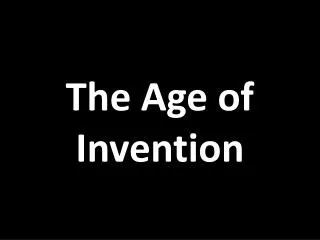
The Age of Invention
The Age of Invention. Sir Henry Bessemer. 1813 – 1898 English Patented the “Bessemer Process,” a method for cheaply mass producing steel, in 1855 Steel would quickly become the building material of choice, since it was stronger, lighter, and more flexible than plain iron. Alfred Nobel.
826 views • 31 slides

The Age of Invention. Industrial Innovations. 1865-1900 the United States experienced a surge of industrial growth Marked beginning of second industrial revolution In the late 1800's steel helped spur a second industrial revolution
537 views • 33 slides
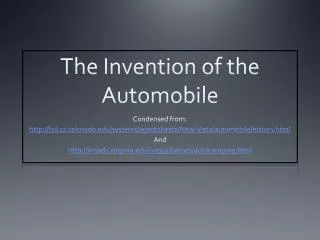
The Invention of the Automobile
The Invention of the Automobile. Condensed from: http://l3d.cs.colorado.edu/systems/agentsheets/New-Vista/automobile/history.html And http://xroads.virginia.edu/~ug02/barnes/autocamping.html. The Automobile Comes to America. By 1900, Europeans had been making cars for fifty years
495 views • 11 slides

THE INVENTION OF FIREWORKS
THE INVENTION OF FIREWORKS. By: Parker Gunnison. History Behind the Invention of Fireworks.
440 views • 4 slides

The Age of Invention. 1. WHAT ADVANCES IN TRANSPORTATION WERE MADE IN THE LATE 1800S? 2. wHich INVENTIONS LED TO A COMMUNICATIONS REVOLUTION? 3. In what ways DID thOMAS EDISON HELP SHAPE THE MODERN WORLD?. TRANSPORTATION.
295 views • 16 slides

The Invention of the Zipper
The Invention of the Zipper. By Maggie Gerrald. Table of Contents. Description of a Zipper How the Zipper came to be The Different Works of the Zipper. Paragraph 1: Description/Materials. Have a part called teeth Teeth keep the material together Teeth have a raised dome Have one slider
403 views • 11 slides
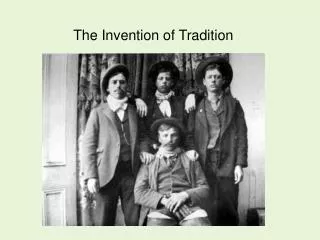
The Invention of Tradition
The Invention of Tradition. Ingredients of tourism . Heritage tourists as consumers in an experience economy Prior knowledge of heritage Expectations of experience Heritage destinations Statement of Significance Making the destination accessible
679 views • 14 slides

INVENTION OF THE WEEK
INVENTION OF THE WEEK. MERVE ÇAPACI. QUESTIONS. What can you do with this screen? Who did create? In which film was used this invention? In the future how can we use this invention?. ANSWERS. You can display from many resources. Warner Bros Star Wars
345 views • 13 slides


The Invention Of…
The Invention Of…. The Telephone. The Beginning….
541 views • 9 slides

Invention of the Car
Invention of the Car. By: Mateo Tucker TMS 5 th period. The car!. The car is a new invention that was made back in the past. The car is worth a lot of money. It has been a good invention ever since. Purpose of the Car. The purpose of the Invention is to help get around places.
2.23k views • 11 slides
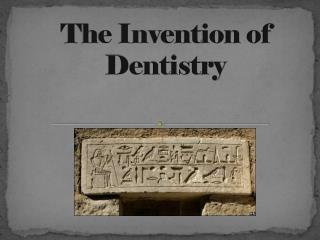
The Invention of Dentistry
The Invention of Dentistry. Who discovered it ?. Historians believe that the earliest evidence of dentistry came from a scientist named Hesy-Re He was considered the first dentist on record His entire concern of scientific practice circled around dental health and treatment. Hesy-Re.
434 views • 11 slides
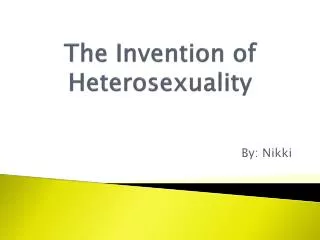
The Invention of Heterosexuality
The Invention of Heterosexuality. By: Nikki. Definitions. Source: Google Images. Heterosexual: relating to, or characterized by a tendency to direct sexual desire toward individuals of the opposite sex. Homosexual: relating to, or having a sexual orientation to persons of same sex.
486 views • 11 slides
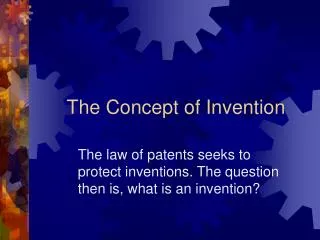
The Concept of Invention
The Concept of Invention. The law of patents seeks to protect inventions. The question then is, what is an invention?. Defining an Invention. Webster’s dictionary defines an invention as “a device, contrivance, or process originated after study and experiment.”. Defining an Invention.
1.4k views • 83 slides

Invention of the Segway
Invention of the Segway. By: Emma Wolf. Dean Kamen. Who invented it?.
307 views • 6 slides

The Invention of Cars
The Invention of Cars. By: Ikea Barnes 8/9 th Period. Nicolas-Joseph Cugnot invented the first car in the world in 1769; it was steam-powered artillery tractor. The first American car was built by Oliver Evans in 1805.
598 views • 10 slides

The Invention of eyeglasses
Group ChocoBuddies' Presentation. The Invention of eyeglasses. The Inventor Of Eyeglasses. Inventor:Salvino D’ Armate Year Of Birth:1258 Year Of Death:1312 Salvino D’ Armate was born in Florence. All About Glasses ….
1.1k views • 11 slides
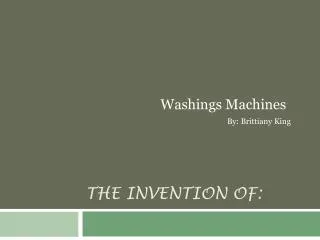
The Invention Of:
By: Brittiany King. The Invention Of:. Washings Machines. Introduction:. A washing machine is a device that it used to separate dirt from clothes. Washing machines come in all different sizes , colors. They also have different brands of washing machines too.
256 views • 14 slides
Invention of the PC
Invention of the PC. By: Ally DelGuidice-Bove. Basic Introduction. . Back in the 1970s, some individuals could buy unassembled PCs and program them in their spare time, but these early computers could not perform most of the beneficial tasks that computers today can .
271 views • 13 slides
- Presentations
- Most Recent
- Infographics
- Data Visualizations
- Forms and Surveys
- Video & Animation
- Case Studies
- Design for Business
- Digital Marketing
- Design Inspiration
- Visual Thinking
- Product Updates
- Visme Webinars
- Artificial Intelligence
Before PowerPoint: The Evolution of Presentations

Written by: Orana Velarde

When PowerPoint was introduced in 1987, presentations changed forever. It wasn’t long before the presentation software took over and tools like overhead projectors and slide carousels became storage room trash.
Before slides were designed on computers, they were made by hand. It took several days to design a slide deck and it was really expensive.
Back in those days, presentations were visualized with tools like paper flip charts and slide projectors, and these were used in classrooms and meeting rooms all over the world.
RELATED: 100+ Creative Presentation Ideas That Will Delight Your Audience
Interestingly, the design of the slides resembled the visual styles found in other fields of graphic design from the same time period. The evolution of presentations has followed trends, just like advertisement and fashion.
In this article, we’ll look at how presentations have evolved over time and how they've turned into the slide decks we know today.
Ancient Presentations
By definition, a presentation is a visual tool designed to help a person tell a story. This story can be for various purposes, including educational, entertainment and even business.
Cave paintings were the first of those "visual tools."
Neanderthal cave paintings, considered to be the first instances of art in human history, were created to tell stories of personal experiences.
These stories were handed down to their children with the help of the drawings they had done on the cave walls.
Jumping ahead thousands of years, another example of historic art can be considered a style of presentation. During the middle ages, Gothic cathedrals were lined with grand colorful stained glass windows.
Stained glass windows at Canterbury Cathedral
The images depicted stories from the Bible and the life of Jesus. The purpose of these windows was to visually enrich the sermons and the preachings given to the congregation.
The same teaching practice is seen in Buddhist temples throughout Southeast Asia. There, teachings are found to be painted on the walls of the monks’ learning areas in equally sized rectangles.
What's interesting is that each painting and each window of ancient times can be considered a “vintage presentation slide.”
Chalkboards and Whiteboards
The first purpose of presentations was education. It wasn’t until later that people started using presentations in offices and sales meetings, too.
The first tool used for presenting lessons to students was the well-known chalkboard. In fact, teachers have used chalkboards for hundreds of years to teach many generations of students.
Some teachers wrote as they spoke, while others prepared the boards beforehand. You could say that the latter was the most similar to the kind of presentations we know of today.
Here's a video of a well-known lecture by author Kurt Vonnegut that not only shows how a chalkboard can be a great presentation tool, but also teaches us about the storytelling process itself:
For decades, scientists and mathematicians used chalkboards to present their findings. Their complicated calculations filled large boards. While explaining, they pointed at different sections of the board with a long stick.
The photograph below shows a group of NASA scientists in 1961 showing a photojournalist how they worked out calculations about space exploration.
There are no real calculations on this board, only reference equations. Still, the visual message was delivered. It shows how scientists would present their knowledge and make calculations.
NASA scientists presenting their calculations in 1961
Digital Presentations Inspired by Chalkboards and Whiteboards
The chalkboard will always represent the classroom; in all fields of design. Even today, there are plenty of chalkboard and whiteboard presentation templates available for PowerPoint and other alternatives like Visme .
Ironically, chalkboards are now more popular in bars and restaurants than in the classroom. Whiteboards, on the other hand, are now interactive and still used in classrooms around the world.
Paper Flip Charts and Poster Cards
Another tool commonly used in the classroom for presenting information to students before PowerPoint was the flip chart.
The first flip charts were actually printed posters joined together with metal fasteners. Presenters used to flip over these posters one by one to present and explain each one.
Flip charts were created for visual lessons and could be used repeatedly. Teachers could access these flip charts through the school libraries.
The image below is of an antique flip chart titled Science Charts:
Science Charts an educational flip chart from the 1940s
It was used by teachers for presenting information to the students. It’s full of monochrome illustrations that helped the teacher explain the lessons without the need for a chalkboard.
The flip chart above is from the 1940s, and its design is very similar to the style of the textbooks of the era; monochromatic and very detailed.
Flip charts were also used for business. Their first recorded use for a sales meeting was featured in the book, "The Patterson Principles of Selling", showing John Henry Patterson presenting with two flip charts in 1912.
As an example, here's an image of an antique flip chart used by The Coca-Cola Company that seems to be from around the 1940s:
The Coca-Cola Company's flip chart presentation from the 1940s
As we can see, the flip chart above was used for presenting data about advertising practices and effects in the United States.
Unfortunately, we were unable to find any other images of this flip chart presentation that show the rest of its pages.
The image below shows another interesting example of a flip chart presentation being used in a Chevrolet Sales Meeting in the 1950s:
Chevrolet Sales Meeting using a flip chart in the 1950s
The flip chart can be seen right at the back against the wall, where it was probably used by the presenter to convey information about the brand.
If you look closely, you will notice that the design style of the flip chart resembles the design style of print advertisement of the era.
The image below shows a flip chart presentation from Sherwin Williams:
Sherwin Williams' flip chart presentation on employee benefits
The flip chart above was used as a tool to get employees acquainted with their benefits while being part of the Sherwin Willams family.
This flip chart is from some time around the ’60s or ’70s. The black and white illustrations resemble magazine advertisements of the 1960s.
Printed flip charts like these are sometimes still used in common work areas or employee rest areas.
The image below, for example, shows a flip chart with emergency procedures for a large company:
Flip chart on workplace emergency procedures
Flip charts like these are still used today because they can be easily laminated, hung on a wall and looked at whenever needed. The "slide" design resembles the colorful 90s style of design.
The first paper flip chart was introduced in the 1970s by Peter Kent. The paper flip chart is a large block of white paper sheets clipped on to a freestanding whiteboard.
Presenters can draw or write on a paper flip chart while speaking, or pre-design it with charts, graphs, and illustrations.
Flip charts were mostly used before PowerPoint came along, but they have also become a bit of a cult classic for giving live presentations. Many people still use them and swear by them for their projects.
Here's a quick video tutorial on how to use flip charts and why they might sometimes be better than digital slides:
In the 1960s, between flip charts and projectors, some presentations were visualized with cardboard posters mounted on wooden easels.
In the TV show Mad Men, this presentation technique was seen being used for the pitch meetings in Don Draper’s creative agency.
The video below is a clip from an episode in which Peggy uses large cardboard visuals in a pitch to a Burger Restaurant:
She switches from card to card by moving them over to an easel next to the one before it. In other instances, they would flip the card as a big reveal.
As another example, here is a photograph of a sales meeting at the Oscar Meyer Company. Notice how the men are holding a poster card with a sales data chart and showing it to Mr. Oscar Meyer.
Poster card presentation at Oscar Meyer Company's sales meeting
During the 1900s, chalkboards, flip charts, and poster cards were great tools for presenting knowledge and information — but they were limited.
When educators and salespeople wanted to present in a more engaging and interactive way, they used projectors of different kinds.
The first projector was The Magic Lantern. It used a candle or kerosene lamp to project light through the film transparencies, instead of a light bulb.
When electricity was invented, projectors quickly evolved and so did presentation design. Here is a visual timeline of the evolution of projectors:
The first “slides” were seen in filmstrip presentations. These were short 35 mm film negatives projected either on a wall or with a filmstrip machine.
These machines were controlled by hand with a wheel on the side. This wheel would advance the filmstrip one frame, or "slide", at a time.
Educators had access to prepared filmstrip presentations just how they had access to the scientific flip charts. The prepared filmstrips were usually accompanied by an audio file on a vinyl record.
RELATED: How to Create a Narrated Presentation With Voice Over Using Visme
In other instances, the filmstrips came with a printed text which the teacher would read during the presentation to explain things better.
The audio recordings that accompanied filmstrip presentations had a specific sound prompt to let the teacher know when it was time to change to the next frame/slide. The printed text had written prompts, too.
More modern filmstrip machines had automatic slide movements and a slot for a cassette tape which would play in sync with the filmstrip.
The video below shows how filmstrips were viewed in the classroom during the 1970s. It shows a series of filmstrips created by Disney Studios about getting to school safely, with the help of Winnie the Pooh:
There were many other filmstrips like these available in schools for educating kids on different subject matters.
Slides, Transparencies and the Rise of The Slide Designer
In terms of slide design, the first instances in history where we see actual slide design practices were in the opening and ending credits in movies.
The techniques used for these frames formed the basis for all the slide design techniques that followed. In the 60s and 70s, these techniques were used to create informational filmstrips, much like the one below:
The Hungarian website below has a great collection of filmstrip and slide deck series dated as far back as the 1920s up until the 1980s.
Many of the slide decks in this collection have a similar design; very simple composition of image and text. In some cases, the designs are a bit more complex. But for the most part, they seem more educational than creative.
Hungarian website showcasing old filmstrips and slide decks
Pre-made filmstrips you could get from film studios were great, but they were not always what educators or sales people needed.
This need was the reason for the rise of the slide designer. Teachers started to learn how to create slides and transparencies for their own lessons with the help of videos like the one below:
The video above shows techniques to create transparencies and slides by hand to use on overhead projectors and other types of projectors, which needed different size transparencies.
It's interesting to note that the evolution of these projectors went hand in hand with the evolution of slide design.
Handmade slides and transparencies were great for the classroom, but they were not very practical for use in the business space.
For a sales meeting, transparencies had to be prepared days in advance. They then had to be transported in special protective folders along with the machinery needed to present them.
Need to create professional-looking visual content in a few minutes?
- Choose from dozens of professionally designed templates
- Create banner ads, social media graphics, and more
- Customize anything to fit your brand image and content needs
To better understand how slide design evolved, it’s necessary to understand the difference between slides and transparencies.
Transparencies are essentially any type of see-through material, like paper or film, through which light is able to pass.
In slide design terms, a transparency is an acetate sheet on which the design is printed on. It's then presented using an overhead projector.
Teachers used overhead projectors in classrooms for a fairly long time during the 70s, 80s and well into the 90s.
They used prepared transparency slides, which they could also write on, and gave lessons with the information projected on a screen or whiteboard.
Overhead projectors were also used for business purposes, such as during meetings with prepared printed transparencies.
Image source
A slide is very similar to the acetate transparency, but much smaller. Each slide is one frame of film cut from a filmstrip and placed inside a plastic or cardboard frame. Slides are photographic negatives, this means that they are photographs of designs prepared first on paper.
A set of slides was presented with a slide projector. The first ones had slide boxes with a manual slider that brought each slide in front of the light bulb.
In 1965, the well-known Kodak Carousel was introduced. It was then that more sophisticated slide designs eventually started to emerge, such as slide transitions and visual effects.
Ironically, the series finale of Mad Men — a TV series about a marketing company in the 1960s — includes a memorable scene in which the main character pitches a marketing idea for the Kodak Carousel.
The Role of the Slide Designer
As slide and transparency projectors became more popular, companies wanted to have their own slide decks for sales meetings and pitches.
The way slides were designed was very similar to the technique behind print advertising . The designs were first put together on white paper using rulers, Exacto knives, rubber cement, and typesetting sheets.
Each slide was designed as a standalone design on a large piece of paper. It had to be proofread and checked for errors until it was just right.
When the large slide designs on paper were ready, they were photographed professionally one by one. The negative filmstrip was then cut slide by slide and framed on the plastic casings.
Designing the slides took many hours of work, which is why slide designers focused mainly on that task. Creative agencies were hired to create slide decks days or weeks ahead of time for a meeting or presentation.
Below is a slide deck for a sales pitch by GE from the 1950s, designed in the way described above:
Advancement of Technology
As technology advanced, so did the evolution of presentations. Slide designers moved from creating slides by hand to creating them on computers with early design programs.
In 1987, when PowerPoint was released, slide designers quickly jumped on board to learn the program and get presentations done faster.
The design style of the first presentations created in PowerPoint was limited by what PowerPoint had to offer. The first ever PowerPoint version was launched for Apple computers in black and white.
Here's what the first ever PowerPoint presentations used to look like:
Users could also change the colors with the help of pre-designed color schemes available in the program.
When PowerPoint first came into the scene , it was only available to those with computers, like advertising and creative agencies.
Even though a finished presentation could be looked at on the computer screen, the designs were still turned into slides for a carousel, transparencies for an overhead, or printed as flip charts.
Computer screens were quite small, so projected slides looked a lot better. In the video below, Microsoft is explaining how PowerPoint worked with the color and storyboard settings:
All About Clip Art
By the mid-90s, computers were well on their way to invading every family home. PowerPoint was the go-to program for making presentations.
Everyone used it — teachers, students, and of course, every company meeting had a PowerPoint presentation.
Back in the 90s, every presentation needed visuals — just like they do now. If the person creating the presentation had some design skills, they could create digital images on Paint and copy them into their PowerPoint slides.
But what most people did was resort to Clip Art for their visuals.
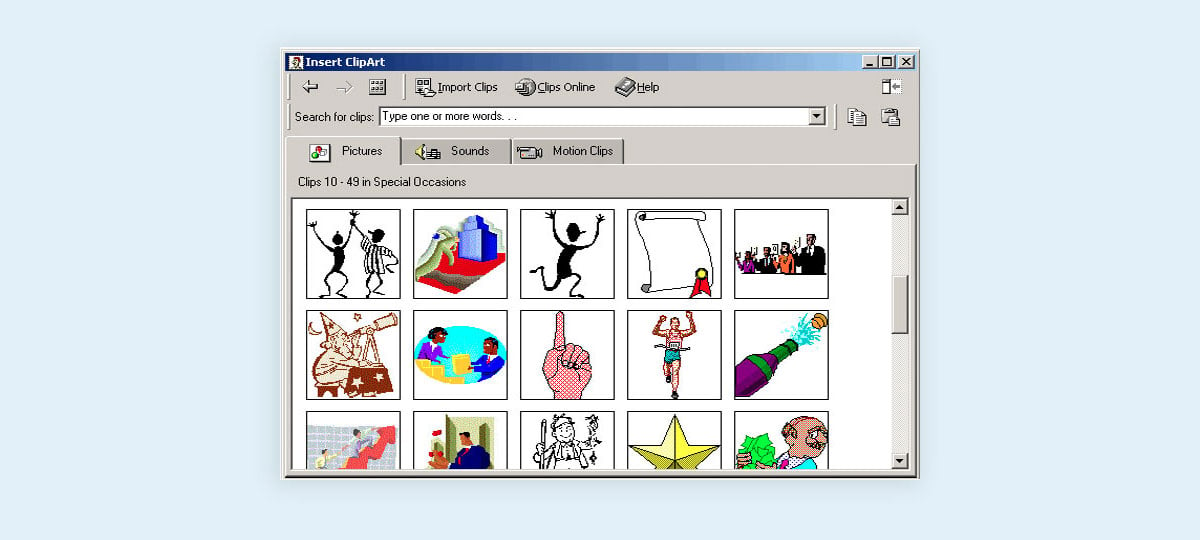
Microsoft's clip art gallery
Clip Art was a bunch of colorful images that came in sets and could be used for any type of digital project.
The first Clip Art collections came in floppy disks and then on CD-ROMs. With the rise of the internet, Clip Art was eventually available online.
In 2014, Microsoft announced that there would be no more Clip Art included in Office software, since most are available online anyway.
Clip art used in Microsoft PowerPoint 2000
Death by PowerPoint
With so many people creating PowerPoint presentations, it wasn’t long before the term “Death by PowerPoint” was coined.
Death by PowerPoint means that a presentation is so boring and poorly designed, the audience has essentially “died” in their seats and aren’t paying attention, much less enjoying themselves.
Much was said about Death by PowerPoint in the early 2000s. It’s still the go-to term when teaching people what NOT to do when creating a PowrPoint presentation.
Not much later, other presentation software started popping up, including Keynote by Apple, Prezi, and Google Slides.
But no matter what software a presenter used, they still had to do their best to avoid “Death by PowerPoint.”
Check out this video by Don McMillan where he gives a humorous talk about Death by PowerPoint and tips on how to avoid it:
Evolution of Presentations: Today and Beyond
With all the presentation software available now, the actual design style of the slides depends greatly on the creator of the presentation.
Presentations made with Prezi, for example, are easy to spot. The zoom in and out animation effect is their visual characteristic.
In the same way, other presentation software has its own unique aspects, making their slides just a little different from the rest.
Not only are there tons of different types of software, there are also thousands of templates available for all platforms.
There are so many different options now that we can’t really point to a single design style. But there are some trends that float to the top every year, which we use as a source of inspiration for our presentations.
At Visme, we make it really easy for you to create presentations that are timeless. With the slide library, you get a good base to work with and it's easy to add your own style.
We also have a great collection of simple background templates, which can be a lifesaver if your creative streak is running low.
Need to create professional-looking presentations in minutes?
- Create animations, charts, graphs, and more
As for the future of presentation design, we are sure to see more interactivity and seamless non-intrusive animations.
We are already starting to see that trend, like in Prezi’s unique “conversational” approach to animated transitions.
Another innovative feature worth mentioning here is Visme’s integrated slide transitions, which all of our presentations include out of the box.
As a result, completed Visme presentations feel more like smooth videos instead of clunky slide decks.
Future trends in presentation design will come and go but what will always stay as a rule is to steer clear of “death by PowerPoint.”
Did you like this brief recap on the evolution of presentations? Let us know your questions, comments and feedback below!
Create beautiful presentations faster with Visme.

Trusted by leading brands
Recommended content for you:

Create Stunning Content!
Design visual brand experiences for your business whether you are a seasoned designer or a total novice.
About the Author
Orana is a multi-faceted creative. She is a content writer, artist, and designer. She travels the world with her family and is currently in Istanbul. Find out more about her work at oranavelarde.com
Contact us today! 905-475-9263

- Document Scanning
- Document Management
- Accounts Payable
- Accounts Receivable
- Children's Aid Societies
- Customer Service
- Human Resources
- Libraries and Archives
- Manufacturing
- Municipal Government
- Pension Administration
- Unions and Member Services
- Mitigate Risk
- Reclaim Office Space
- Secure a Competitive Advantage
- Business Process Improvement
- Document Management Software
- Scan to Zero
- Document Scanning Services
- Business Processing Services
- Microfilm Scanning
- Scanning Hardware
- eBooks, Guides & More
- The Definitive Guide to Accounts Payable Automation
- The Ultimate Guide to Automation for Accounts Receivable Management
- Document Scanning Best Practices
- Information Chaos Team
- File Request
- Service Request
Document Management Blog
A brief history of paper to digital documentation.
Topics: paper usage , paper documents , manual document filing , process management , document management trends , document management , business process automation , digital transformation
Startups do things digitally. But companies that have been around for decades largely don’t. It seems impossible to believe, but 82% of companies are still paper-based.
“With all the lip service paid to innovation, it’s astounding that most businesses still use technology invented more than 2,000 years ago. We’ve entered the era of 3D printing, artificial intelligence, and missions to Mars — yet only 18 percent of companies consider themselves paperless.”
—Corp! Magazine

With cloud servers and apps like Monday, Trello, and Evernote replacing paper calendars, notebooks, and whiteboards, it seems crazy to think that less than 20% of all companies in 2020 operate digitally. Not so crazy, though, when you consider that computers weren’t even part of the office environment 40 years ago.
Let’s take a look at the brief history of paper to digital documentation and nail down when paper processes will finally go digital.
Egyptians created the first form of paper, papyrus 5000 years ago. Fast forward 3000 years and paper was invented in China in 100BC, which quickly replaced papyrus because it was quicker and cheaper to make. Ink soaked into paper (with papyrus, ink sat on top), making contracts more secure.
Fast forward to 1440 when Johannes Gutenberg created the printing press, the first efficient way to make copies with moveable typeset. Gutenberg birthed the printing revolution and catapulted the advancement of communication around the world. In 1938 the press becomes portable, small, and affordable when Seattle inventor Chester Carlson invented the first printer, called the Xerox. In 1968 the dot matrix printer was born, followed by the laser printer in 1969.
Computers have been part of the office mainstream since the 1980s. Adopting computers in the office was commonplace by the 1990s. Most businesses used computers for word processing and accounting and clunky desktop printers to print documents, store them in folders, and file them in cabinets.
Portable documents
By the end of the 1990s, the world wide web (www) offered useable bandwidth and the internet became a functional tool of the workplace. Right around this time, in 1993, Adobe gave the world the PDF, a universal Portable Document Format. PDFs made sharing and viewing files easy regardless of operating system or software.
Around the turn of the century, server capabilities advanced to the point where it made more sense to store files in digital folders than in gigantic metal cabinets. No need to keep printing documents and cutting down the rainforests, right?
Servers weren’t cloud-based and, along with a general mistrust of digital, if a server went down, intellectual property could be lost forever without a paper backup copy. Things weren’t where they needed to be for businesses to jump in with digital.
So when did we hit that magical date when digital could be trusted?

Cloud computing wasn’t even a term until 2006 when Google CEO Eric Schmidt used it for the first time at an industry conference. That same year, Amazon launched web services and Google launched Google Docs and Google Sheets, internet-based programs that could be created, updated, and shared online. In 2007, Netflix launched video streaming using the cloud. Binge-watching may take credit for making the cloud a cozy thing. It wasn’t until 2011 that IBM and Apple launched their cloud services. The next year, Oracle Cloud introduced Software as a Service (SaaS) to the world. But it wasn’t until 2014 that Cloud Computing put a focus on security.
"Cloud security has advanced significantly [and] now provides protection comparable to traditional IT security systems. This includes the protection of critical information from accidental deletion, theft, and data leakage. Having said that, security is, and may always be, the primary concern of most Cloud users." ( A Brief History of Cloud Computing )
If we use 2014 as the year that Cloud services went from obscurity to becoming a secure useable system of the modern enterprise, we’ve only been in a position to go safely paperless for six years. So it’s really not that hard to fathom that most businesses haven’t made the switch from paper to digital.
But six years removed or not, there are too many disadvantages to staying that way. It’s 2020 and the only excuse for not “going paperless” is the dip in productivity that happens during the conversion from paper to digital. But outsourcing that conversion to a document management company keeps you up and running as you realize the benefits of a digital system in the background.
Contact MES to help bring you up to speed. It's time to go paperless.

You May Also Enjoy Reading:
Posts by topic.
- Document Management and ECM (216)
- MES Hybrid Document Systems (156)
- document scanning (128)
- Records Management (54)
- microfilm (43)
- document management software (41)
- paperless office (41)
- document scanning services (37)
- paperless (33)
- document management solutions (32)
- Scanners (29)
- document management (26)
- digital transformation (25)
- data security (17)
- document imaging (17)
- electronic medical records (16)
- record management (16)
- Archiving Documents (14)
- Film Scanners (14)
- Archive Writing (13)
- accounts payable (13)
- document storage (13)
- human resources (13)
- paper scanning (13)
- Document management company in Ontario (12)
- Document management in Ontario (12)
- document management system (12)
- Document Scanning Services in Ontario (11)
- Electronic Records (11)
- office automation (11)
- Book Scanner (10)
- Cloud Computing (10)
- Digital Document Services (10)
- Document Scanner (10)
- Document Scanning Toronto (10)
- cloud storage (10)
- digital storage (10)
- document management company (10)
- paper documents (10)
- Document scanners in Ontario (9)
- Workflow (9)
- information security (9)
- microfilming (9)
- online document management (9)
- Document Management Toronto (8)
- Document Scanning in Ontario (8)
- Document management software in Ontario (8)
- Ontario document management (8)
- automated workflows (8)
- business process automation (8)
- digital archives (8)
- document scanning solutions (8)
- document security (8)
- library scanning (8)
- microfilm scanners (8)
- records retention (8)
- Microfilm scanning (7)
- microfiche (7)
- records storage (7)
- student records management (7)
- Document Retention (6)
- aperture cards (6)
- document indexing (6)
- document management requirements (6)
- invoice automation (6)
- microfilm scanner (6)
- record retention (6)
- scan to zero (6)
- DocuWare (5)
- ECM Sotware (5)
- ECM document management software (5)
- Ontario record management (5)
- Ontario records management (5)
- Student Records Management in Ontario (5)
- accounts receivable (5)
- automation (5)
- book scanning (5)
- customer service (5)
- data storage (5)
- digital documents (5)
- digital records (5)
- digitizing (5)
- document management trends (5)
- document scanners (5)
- file management software (5)
- libraries (5)
- medical document scanning (5)
- mes hybrid (5)
- paper records management (5)
- productivity (5)
- Document Managing Process (4)
- Library Scanners (4)
- Microfilm Scanning Services (4)
- Ontario Library Association Expo (4)
- Ontario record management solutions (4)
- Toronto (4)
- accounting (4)
- archives (4)
- archiving documents in Ontario (4)
- business efficiency (4)
- business processes (4)
- compliance (4)
- digitizing library (4)
- document archiving (4)
- document automation (4)
- document scanning products (4)
- document scanning service (4)
- document workflows (4)
- healthcare (4)
- how to scan documents (4)
- library (4)
- manual document filing (4)
- protecting paper documents (4)
- record management solutions (4)
- records scanning (4)
- secure document storage (4)
- shared drives (4)
- student record management (4)
- Document Management Solutions in Ontario (3)
- Efficiency (3)
- FileBound (3)
- FileDirector in Ontario (3)
- Financial Document Management in Ontario (3)
- High Speed Document Scanners (3)
- Microfiche Scanners (3)
- Rollfilm (3)
- data compliance laws (3)
- data preservation (3)
- digital (3)
- digital imaging (3)
- digital mailroom (3)
- document management in Toronto (3)
- document management tools (3)
- document scanning process (3)
- document software (3)
- electronic document management (3)
- file management (3)
- filing systems (3)
- going green (3)
- government security (3)
- high capacity scanners (3)
- information management (3)
- invoice processing (3)
- micrographics (3)
- organizing files (3)
- paper usage (3)
- physical records management (3)
- record management software (3)
- records management trends (3)
- scan to pdf (3)
- shared documents (3)
- the cloud (3)
- Aperture Card Scanners in Ontario (2)
- Aperture card scanners (2)
- Archive Writing in Ontario (2)
- Are digital images legal (2)
- Departmental Scanners in Ontario (2)
- Disaster Recovery (2)
- Document Scanning Equipment in Ontario (2)
- Document management Hamilton (2)
- Document management software Hamilton (2)
- Document scanning Markham (2)
- E-Forms in Ontario (2)
- Guiding Principles (2)
- Large Format Scanners in Ontario (2)
- MES Hybrid Document (2)
- Microfilming Services (2)
- Ontario document management systems (2)
- Ontario microfilm (2)
- Records Management in Ontario (2)
- Records Scanning in Ontario (2)
- Toronto Document Management (2)
- Wireless Network Scanners in Ontario (2)
- book scanners (2)
- build a business case (2)
- business growth (2)
- business strategy (2)
- child care modernization (2)
- cloud vs. on-site (2)
- converting microfilm to digital images (2)
- customer service experience (2)
- data theft (2)
- digital files (2)
- digital organization (2)
- document management services (2)
- document management systems (2)
- document preservation (2)
- document protection (2)
- document scanning equipment (2)
- mailroom (2)
- metadata (2)
- microfiche scanner (2)
- microfilm readers (2)
- microfilm scanning in Ontario (2)
- microfilm storage (2)
- paperless billing (2)
- process management (2)
- questions to ask (2)
- records management legislation (2)
- reduce paper use (2)
- share information (2)
- small business (2)
- sustainability (2)
- workforce mobility (2)
- 12.12.12 (1)
- Accessibility (1)
- Aperture Card Scanning (1)
- Are you considering acquiring the data capture ser (1)
- Business Process Improvement (BPI) (1)
- CGSB-72.11.93 (1)
- Canon Microfilm (1)
- Canon Scanner (1)
- Company Culture (1)
- Cost Savings (1)
- Data Management (1)
- Data Storage Solutions (1)
- Digital Archiving (1)
- Digitization (1)
- Document Retention Policy (1)
- Document management software Ontario (1)
- Electronic Document Management System (1)
- Electronic Records Management (1)
- File Formats (1)
- FilePrint (1)
- Formatta in Ontario (1)
- Fujitsu Scanner (1)
- HIPAA Compliance (1)
- Healthcare Efficiency (1)
- MES ViewScan (1)
- Medical Records Scanning (1)
- Microfiche Digitization (1)
- Microfiche Scanning (1)
- Microfilm Digitization (1)
- Microfilm scanning Markham (1)
- Microfilm scanning services Hamilton (1)
- Microfilming Hamilton (1)
- Microfilming in Ontario (1)
- Ontario Document Archiving (1)
- Ontario Document Scanning (1)
- Ontario Microfilming (1)
- Paper Waste (1)
- Patient Care (1)
- Records Scanning Service (1)
- Records Storage Facility (1)
- Scanning Documents (1)
- Secure Storage (1)
- ViewScan (1)
- Webinar (1)
- Wide Format Scanners in Ontario (1)
- Workflow Automation (1)
- alternative to micrographics (1)
- archive (1)
- archive writing services (1)
- archive writing system (1)
- business continuity (1)
- business records (1)
- cheap microfilm prices (1)
- child protection information network (1)
- content services (1)
- cost of document storage (1)
- cybersecurity (1)
- data entry (1)
- data hoarding (1)
- data indexing (1)
- data loss (1)
- data protection (1)
- departmental scanners (1)
- digital destruction (1)
- digital library (1)
- digital office (1)
- digital reel (1)
- document imaging services (1)
- document management resources (1)
- document solutions (1)
- e-forms software (1)
- education (1)
- email retention (1)
- enterprise document scanning (1)
- future of microfilm (1)
- future of micrographics (1)
- hospital records management (1)
- how much paper do I have (1)
- image verification (1)
- information risk (1)
- insurance (1)
- life after microfilm (1)
- manufacturing (1)
- manufacuring (1)
- membership records (1)
- mes hybrid document management syste (1)
- microfilm alternatives (1)
- microfilm products (1)
- microfilm reader printer (1)
- microfilm replacement (1)
- microfilm suppliers (1)
- microfilm toner (1)
- moving tips (1)
- network drive (1)
- network scanner (1)
- network scanners Hamilton (1)
- newspaper scanning (1)
- on site scanning (1)
- on-site software (1)
- ontario library association (1)
- payroll (1)
- portable scanner (1)
- process documentation (1)
- public scanning (1)
- questions about document scanning (1)
- record scanning (1)
- records management laws (1)
- remote access (1)
- remote documents (1)
- resume screening (1)
- return on investment (1)
- scanning patient files (1)
- scanning services toronto (1)
- security (1)
- sharing documents (1)
- shredding (1)
- spring cleaning (1)
- student records (1)
- time management (1)
- uman resources (1)
- version control (1)
- wireless network scanners (1)
- workplace security (1)
- zeta book scanner (1)
- Document Solutions
- Document Management Resource Centre
- Privacy Policy
200 Amber Street Markham, ON L3R 3J8
Phone: 905-475-9263
Email: [email protected]
Web: www.MESLTD.ca
Embrace Paperless!
Call today for your free quote and document management plan.

Princeton Correspondents on Undergraduate Research
How to Make a Successful Research Presentation
Turning a research paper into a visual presentation is difficult; there are pitfalls, and navigating the path to a brief, informative presentation takes time and practice. As a TA for GEO/WRI 201: Methods in Data Analysis & Scientific Writing this past fall, I saw how this process works from an instructor’s standpoint. I’ve presented my own research before, but helping others present theirs taught me a bit more about the process. Here are some tips I learned that may help you with your next research presentation:
More is more
In general, your presentation will always benefit from more practice, more feedback, and more revision. By practicing in front of friends, you can get comfortable with presenting your work while receiving feedback. It is hard to know how to revise your presentation if you never practice. If you are presenting to a general audience, getting feedback from someone outside of your discipline is crucial. Terms and ideas that seem intuitive to you may be completely foreign to someone else, and your well-crafted presentation could fall flat.
Less is more
Limit the scope of your presentation, the number of slides, and the text on each slide. In my experience, text works well for organizing slides, orienting the audience to key terms, and annotating important figures–not for explaining complex ideas. Having fewer slides is usually better as well. In general, about one slide per minute of presentation is an appropriate budget. Too many slides is usually a sign that your topic is too broad.

Limit the scope of your presentation
Don’t present your paper. Presentations are usually around 10 min long. You will not have time to explain all of the research you did in a semester (or a year!) in such a short span of time. Instead, focus on the highlight(s). Identify a single compelling research question which your work addressed, and craft a succinct but complete narrative around it.
You will not have time to explain all of the research you did. Instead, focus on the highlights. Identify a single compelling research question which your work addressed, and craft a succinct but complete narrative around it.
Craft a compelling research narrative
After identifying the focused research question, walk your audience through your research as if it were a story. Presentations with strong narrative arcs are clear, captivating, and compelling.
- Introduction (exposition — rising action)
Orient the audience and draw them in by demonstrating the relevance and importance of your research story with strong global motive. Provide them with the necessary vocabulary and background knowledge to understand the plot of your story. Introduce the key studies (characters) relevant in your story and build tension and conflict with scholarly and data motive. By the end of your introduction, your audience should clearly understand your research question and be dying to know how you resolve the tension built through motive.

- Methods (rising action)
The methods section should transition smoothly and logically from the introduction. Beware of presenting your methods in a boring, arc-killing, ‘this is what I did.’ Focus on the details that set your story apart from the stories other people have already told. Keep the audience interested by clearly motivating your decisions based on your original research question or the tension built in your introduction.
- Results (climax)
Less is usually more here. Only present results which are clearly related to the focused research question you are presenting. Make sure you explain the results clearly so that your audience understands what your research found. This is the peak of tension in your narrative arc, so don’t undercut it by quickly clicking through to your discussion.
- Discussion (falling action)
By now your audience should be dying for a satisfying resolution. Here is where you contextualize your results and begin resolving the tension between past research. Be thorough. If you have too many conflicts left unresolved, or you don’t have enough time to present all of the resolutions, you probably need to further narrow the scope of your presentation.
- Conclusion (denouement)
Return back to your initial research question and motive, resolving any final conflicts and tying up loose ends. Leave the audience with a clear resolution of your focus research question, and use unresolved tension to set up potential sequels (i.e. further research).
Use your medium to enhance the narrative
Visual presentations should be dominated by clear, intentional graphics. Subtle animation in key moments (usually during the results or discussion) can add drama to the narrative arc and make conflict resolutions more satisfying. You are narrating a story written in images, videos, cartoons, and graphs. While your paper is mostly text, with graphics to highlight crucial points, your slides should be the opposite. Adapting to the new medium may require you to create or acquire far more graphics than you included in your paper, but it is necessary to create an engaging presentation.
The most important thing you can do for your presentation is to practice and revise. Bother your friends, your roommates, TAs–anybody who will sit down and listen to your work. Beyond that, think about presentations you have found compelling and try to incorporate some of those elements into your own. Remember you want your work to be comprehensible; you aren’t creating experts in 10 minutes. Above all, try to stay passionate about what you did and why. You put the time in, so show your audience that it’s worth it.
For more insight into research presentations, check out these past PCUR posts written by Emma and Ellie .
— Alec Getraer, Natural Sciences Correspondent
Share this:
- Share on Tumblr

Got any suggestions?
We want to hear from you! Send us a message and help improve Slidesgo
Top searches
Trending searches

17 templates

american history
85 templates

49 templates

43 templates

el salvador
34 templates

art portfolio
100 templates
History Presentation templates
Free history google slides themes and powerpoint templates for your presentations. download them and make your cultural projects stand out with the large amount of graphic resources included., related collections.

718 templates
1175 templates

- Middle School
1083 templates

- High School
1375 templates

1162 templates
- Calendar & Weather
- Infographics
- Marketing Plan
- Project Proposal
- Social Media
- Thesis Defense
- Black & White
- Craft & Notebook
- Floral & Plants
- Illustration
- Interactive & Animated
- Professional
- Instagram Post
- Instagram Stories

It seems that you like this template!
Premium template.
Unlock this template and gain unlimited access

Register for free and start downloading now
Virgil - ancient roman poet presentation template.
Download the Virgil - Ancient Roman Poet Presentation Template presentation for PowerPoint or Google Slides and start impressing your audience with a creative and original design. Slidesgo templates like this one here offer the possibility to convey a concept, idea or topic in a clear, concise and visual way, by...

Social Studies & History Subject for Middle School - 6th Grade: Ancient World History
Learning about our past is the best way of understanding our present. This template is perfect to present your students the different civilizations that emerged in ancient history and make them passionate about history. The slides have an appealing antique look that will take your audience in a trip to...

Chernobyl Disaster
Download the Chernobyl Disaster presentation for PowerPoint or Google Slides and start impressing your audience with a creative and original design. Slidesgo templates like this one here offer the possibility to convey a concept, idea or topic in a clear, concise and visual way, by using different graphic resources. You...

History Lesson for High School: The Soviet Union
Download the History Lesson for High School: The Soviet Union presentation for PowerPoint or Google Slides. High school students are approaching adulthood, and therefore, this template’s design reflects the mature nature of their education. Customize the well-defined sections, integrate multimedia and interactive elements and allow space for research or group...

Papyrus History Lesson
History lessons tend to be boring for students, since they need to remember dates and a bunch of information. Make it entertaining by editing our free presentation template, whose backgrounds based on ancient papyrus rolls take it to the next level.
Powerful Predators
Download the "Powerful Predators" presentation for PowerPoint or Google Slides and teach with confidence. Sometimes, teachers need a little bit of help, and there's nothing wrong with that. We're glad to lend you a hand! Since Slidesgo is committed to making education better for everyone, we've joined hands with educators....

Patriot's Day 9/11
Download the Patriot's Day 9/11 presentation for PowerPoint or Google Slides and start impressing your audience with a creative and original design. Slidesgo templates like this one here offer the possibility to convey a concept, idea or topic in a clear, concise and visual way, by using different graphic resources....

Grimm Brothers' Fairy Tales
Download the Grimm Brothers' Fairy Tales presentation for PowerPoint or Google Slides and start impressing your audience with a creative and original design. Slidesgo templates like this one here offer the possibility to convey a concept, idea or topic in a clear, concise and visual way, by using different graphic...

Thesis Defense - Master of Arts in History
Download the Thesis Defense - Master of Arts in History presentation for PowerPoint or Google Slides. As university curricula increasingly incorporate digital tools and platforms, this template has been designed to integrate with presentation software, online learning management systems, or referencing software, enhancing the overall efficiency and effectiveness of student...

Writing History Thesis
Are you finishing your writing history thesis and need a good presentation to impress the examination board? We propose you this vintage style template that fits wonderfully with the topic. It has a simple design, beige background and doodle illustrations of books, papyrus, quills, etc. that add sophistication to your...

Social Studies Subject for Middle School: Protestant Reformation
Download the Social Studies Subject for Middle School: Protestant Reformation presentation for PowerPoint or Google Slides. If you’re looking for a way to motivate and engage students who are undergoing significant physical, social, and emotional development, then you can’t go wrong with an educational template designed for Middle School by...

Reconstruction Era and the Gilded Age - History - 11th Grade
In the United States, the Reconstruction Era followed the Civil War and sought to unite the nation and grant civil rights. The Gilded Age brought industrial growth, but also inequality and corruption. Both eras shared the struggle for civil rights and equity. So these are two periods loaded with historical...

Cowboys of the Old West
Howdy, partner! Are you a fan of the Wild West and its legendary cowboys? Want to create a presentation or slideshow that captures the rugged, adventurous spirit of the Old West? Let us introduce you to this editable template and its illustrations! It's easy to put everything into context by...

Create your presentation Create personalized presentation content
Writing tone, number of slides, generation of '27.
Generation of '27 is a group of avant-garde poets and artists who began to publish their work in the 20s of the 20th century. To help you explain this interesting part of Spanish literature to your students, we propose you this old-style brown template, with different illustrations of books, pens,...

Social Studies Subject for Middle School - 8th Grade: Geography and Colonialism
How did we all humans get to know each other? Well, it’s a complicated story about colonialism, discoveries and adventures, but it can be easy to understand if you as a teacher use the correct resources. This template includes maps, timelines, charts and tables that will give your history lesson...

World War II History Analysis Thesis Defense
Prepare to eloquently defend your historical analysis with this World War II presentation template, perfect for a thesis defense! The design mirrors an authentic World War II photo album, offering a vintage appeal that neatly complements your subject matter. The arrangement is elegant, yet functional, with versatile features to help...

Christopher Columbus and the Discovery of America for Children
Download the "Christopher Columbus and the Discovery of America for Children" presentation for PowerPoint or Google Slides and easily edit it to fit your own lesson plan! Designed specifically for elementary school education, this eye-catching design features engaging graphics and age-appropriate fonts; elements that capture the students' attention and make...

Black History Month Historical Figures: Frederick Douglass
Download the "Black History Month Historical Figures: Frederick Douglass" presentation for PowerPoint or Google Slides and start impressing your audience with a creative and original design. Slidesgo templates like this one here offer the possibility to convey a concept, idea or topic in a clear, concise and visual way, by...
- Page 1 of 84
Register for free and start editing online
How to Give a Twenty Minute Oral Presentation
Getting organized….
- Organize your major points on a page or a page and a half of paper.
- Type all quotations (or xerox them) on separate pieces of paper so you can find them at the appropriate time.
- Prepare a transparency or multiple copies for the class if you have special maps, a chronology, technical terms, or illustrations that everyone should see.
When you begin…
- Start out with a strong, clear thesis of what your presentation is all about.
- Make sure you have a limited number of major points which you stress, and illustrate.
- Have a sense of how long you will take by practicing before a mirror or an available roommate.
As you start to write…
- Remember that you will know more than you put down on paper. Try for a limit of ten pages (which is more difficult than fifty!).
- Begin with a substantive statement of the topic/problem you are dealing with.
- End with a summary, with questions that are left unanswered, with a new thought that you would like to pursue. The end of your paper should be as strong and interesting as the beginning.
- Use standard footnote procedures. Jacques Barzun and Henry Graffís The Modern Researcher or Kate Turabianís Manual will serve as references. You may use anthropological style (Author, year of publication: page number) if you organize your bibliography properly: Author. Year. Title. Place of Publication: Publisher.
- Footnotes and bibliography may be at the end; however, footnotes that explain something in the text should be at the bottom of that page. So, if the major notes are at the end, and something in the text needs explaining, use a symbol in the text, * for instance, and place the explanation at the bottom of the page.
- Proofread. No “A” paper can be sloppy, full of typos and misspellings.
– Eleanor Zelliot
See also: How to Lead a Class Discussion

A Complete History of the Poster Session: the Evolution From Paper to ePosters
The advent of the poster session revolutionized the way we share, collaborate, and connect in the world of academia and research. While ePosters have been in use for over a decade, many people still think of rows of poster boards when asked to imagine a poster session. The truth is that the landscape of poster sessions (and scholarly communications in general) has undergone a significant transformation due to technology.
But have you ever wondered, what was it like at the first ever poster session? And how did people share their research before major technological advancements like the internet? This week we’re sharing a historical overview of how the poster session came to be, a look at how posters were revolutionized by technology, and our predictions of how we see the poster session changing in years to come.
The Past: A World Without ePosters
The inclusion of poster sessions at conferences is a surprisingly modern thing. While we can track academic and scientific conferences, in some format or another, all the way back to 1860 when the first international scientific conference took place in Germany, poster sessions didn’t appear on the scene until a century later in the late 1960s.
These early poster sessions were extremely basic, with individual graphs, diagrams, and text printed or drawn onto individual pieces of paper and pinned onto larger boards. This was the norm right into the 1980s, before large-scale printing was an option.
Photo courtesy of the Dorothy W. Hagan photograph collection, 1932-2002, Collection Number 2006-013, Oregon Health & Science University, Historical Collections & Archives
By the time we reach the 2000s, poster sessions had become an integral feature of the scientific or academic conference with thousands of posters being displayed at large international events.

Photo by Steven Rose, 111th American Society for Microbiology General Meeting, New Orleans, LA 2011
While technology developed and tech got smarter and smaller, the conference poster languished in the low-tech, space hogging, litter-creating format of its origins. There have been attempts by creative presenters to bring an element of interactivity and technology to posters, ranging from the Digital Legacy Association’s attempt at a polling feature, to tech-minded students finding ways to attach tablets to their posters to display videos.

Photo by Paulbacca, “Interactive Conference Poster Presentation”, published on Autodesk Instructables
The Present: Embracing the Digital Era of ePosters
While for many digital posters may seem like the future, it was actually back in 2010 when ePostersLive first started offering a digital poster solution to bring posters into the 21st century. By 2011 we went international, supporting the Royal College of Obstetrics and Gynecology, an event we worked with yet again at the end of 2022, over a decade later! The future is already here.
By 2012 it was clear that e-posters were the wave of the future, and that technology was going to transform the scientific conference experience. That year, Nature interviewed our CEO Pavlos Moustakidis, who successfully predicted many of the current trends regarding interactivity and hybrid models. The Nature article signaled that the scientific community at large had embraced electronic posters, and ePostersLive was at the forefront of this progress.

ePostersLive™ in action at the 9th International Scientific Meeting of the Royal College of Obstetricians and Gynaecologists, September 2011
Since that first session, technology has continued to evolve and we now see innovative, engaging, and interactive posters being displayed in a digital format all over the world. Recently we’ve worked with events that have encouraged authors to add video or audio to their posters to give more interaction and engagement. Commenting and contacting tools help the conversation carry on well after an event has ended. Touchscreen compatibility allows the reader to literally zoom in on even the tiniest data point. We’ve even supported totally virtual sessions with delegates dialing in from across the globe to engage with authors.

ePostersLive™ in action at the 2022 ASA Annual Meeting, October 2022
The Future: ePostersLive in the Vanguard of Scientific Communication
Ultimately, there is always room for growth. Especially when it comes to accessibility and ease of scholarly communication, in the case of eposters. Recent trends toward improving interactivity and poster engagement are coming alongside a wider shift in how authors choose to format and design their posters, like the #BetterPoster movement. The good news is that at each conference, we continue to see researchers try new things and experiment with how to present their work in the most meaningful and lasting way possible.
It’s safe to say there are some exciting advancements on the horizon, at ePostersLive and beyond. We can’t wait to see what the next stage in poster session innovation will be, but you can be sure it will be SciGen Technologies leading the way once again.
FOLLOW US ON SOCIAL MEDIA
Copyright © 2010-2023 SciGen® Technologies. All rights reserved. ePostersLive, PosterGenius and SciGen are USPTO registered trademarks of SciGen Technologies. Patent pending.
- Privacy Policy

IMAGES
VIDEO
COMMENTS
404.894.7840 (phone) • 404.894.4778 (fax) • paper.gatech.edu History of Papermaking Around the World Pre-Paper Before paper was invented, people around the world used many different materials as writing surfaces. Local environments influenced the kinds of materials used: clay tablets, tree bark, or materials such as papyrus and parchment.
The word "paper" is etymologically derived from papyrus, Ancient Greek for the Cyperus papyrus plant. Papyrus is a thick, paper-like material produced from the pith of the Cyperus papyrus plant which was used in ancient Egypt and other Mediterranean societies for writing long before paper was used in China. [4]Papyrus is prepared by cutting off thin ribbon-like strips of the pith (interior) of ...
History of Paper - Free download as Powerpoint Presentation (.ppt), PDF File (.pdf), Text File (.txt) or view presentation slides online. The origins of paper can be traced back over 5,000 years to ancient Egypt, where papyrus reeds were cut and layered to form sheets. However, modern paper as we know it was invented in China in 105 AD by Ts'ai Lun, who developed a papermaking process using ...
This is the History module of the Introduction to Papermaking Short Course. It talks about the invention of paper, its movement across the globe and some of ...
Brief History. Being used in Ancient China since 2nd century BC, paper made a little impact until inventor Cai Lin managed to refine its production process, enabling the beginning of the true revolution of paper products all across the china. His technique could be used to reliable and quickly create small sheets of paper from heated wood chips ...
This early adoption of paper fueled the Korean innovations in printing, as well. Metal movable type was invented by 1234 CE on the peninsula. Around 610 CE, according to legend, the Korean Buddhist monk Don-Cho introduced paper-making to the court of Emperor Kotoku in Japan. Paper-making technology also spread west through Tibet and then south ...
Take your students on a fascinating journey through global history! Speak about human evolution, cultural and religious history, important inventions and political developments with this lovely presentation template with a background of creamy, vintage paper scraps. You can edit the graphs, map and everything else in these slides easily, so don ...
A Brief History of Paper. Before paper, we used materials like stone and bone to record history and communicate with one another. It didn't look anything like the lined and perforated paper we commonly use now. Egyptians created a material similar to paper in 3000 B.C. using papyrus, a plant reed that only grew regionally.
History of Papermaking. Paper gets its name from the Egyptian papyrus plant, used to make paperlike sheets as early as 2300 bc (see papyrus plant). The Chinese, before discovering how to make paper, wrote on tablets of silk or bamboo. Europeans recorded documents on the skins of calves, lambs, sheep, and goats.
papermaking, formation of a matted or felted sheet, usually of cellulose fibres, from water suspension on a wire screen. Paper is the basic material used for written communication and the dissemination of information. In addition, paper and paperboard provide materials for hundreds of other uses, such as wrapping, packaging, toweling ...
Paper is one of humanity's most important inventions, helping to document and preserve information for thousands of years. Ahead of the release of our Paper Guide, read our article on the history of paper from 3100 B.C. to the present.. Featured Image: Illustration demonstrating an early method of papermaking - bamboo was treated and boiled to make a pulp, and then a fine screen was dipped ...
Invention Paper was invented in China by CaiLun in 105 AD. It was one of the one of the four greatest inventions of the Chinese. He was looking for a device to record events and important things. How it is made Paper can be made from a variety of materials ranging from tree bark, hemp, rags, etc. CaiLun made paper by mixing finely chopped ...
The History of Paper. The history of paper is an interesting one. Read onto discover the journey that paper making went on before it became what we know today. 105 AD - Ts'ai Lun, an official of the Imperial court of China, creates paper as we would recognise it. He created it using fibres from wood and bark, as well as other fibrous ...
The first paper flip chart was introduced in the 1970s by Peter Kent. The paper flip chart is a large block of white paper sheets clipped on to a freestanding whiteboard. Presenters can draw or write on a paper flip chart while speaking, or pre-design it with charts, graphs, and illustrations.
Paper. Egyptians created the first form of paper, papyrus 5000 years ago. Fast forward 3000 years and paper was invented in China in 100BC, which quickly replaced papyrus because it was quicker and cheaper to make. Ink soaked into paper (with papyrus, ink sat on top), making contracts more secure.
Vintage Paper History Lesson Infographics. Premium Google Slides theme, PowerPoint template, and Canva presentation template. Teach your students everything they didn't know about the history of paper but should! This vintage collection of infographics can help you detail the first kinds of paper, their evolution throughout history and so ...
Limit the scope of your presentation. Don't present your paper. Presentations are usually around 10 min long. You will not have time to explain all of the research you did in a semester (or a year!) in such a short span of time. Instead, focus on the highlight(s). Identify a single compelling research question which your work addressed, and ...
as been more convincing than the other(s).s Scenario #2: Scholars have disagreed about my topic, and my paper demonstrates why the entire debate needs t. be recast in a more meaningful direction.s Scenario #3: Scholars have (more or less) agreed about my topic, and my paper argues for a differe. ion.Familiar Argu.
Download the History Lesson for High School: The Soviet Union presentation for PowerPoint or Google Slides. High school students are approaching adulthood, and therefore, this template's design reflects the mature nature of their education. Customize the well-defined sections, integrate multimedia and interactive elements and allow space for ...
Try for a limit of ten pages (which is more difficult than fifty!). Begin with a substantive statement of the topic/problem you are dealing with. End with a summary, with questions that are left unanswered, with a new thought that you would like to pursue. The end of your paper should be as strong and interesting as the beginning.
History presentations can be a powerful tool for educators to teach students about significant events and concepts throughout history. However, creating an effective history presentation can be a
A Complete History of the Poster Session: the Evolution From Paper to ePosters. Jun. 22. 2023. The advent of the poster session revolutionized the way we share, collaborate, and connect in the world of academia and research. While ePosters have been in use for over a decade, many people still think of rows of poster boards when asked to imagine ...